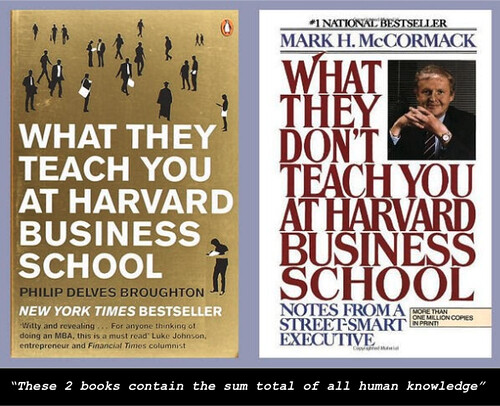
About UsThe Numismatic Bibliomania Society is a non-profit association devoted to the study and enjoyment of numismatic literature. For more information please see our web site at coinbooks.org SubscriptionsThose wishing to become new E-Sylum subscribers (or wishing to Unsubscribe) can go to the following web page link MembershipThere is a membership application available on the web site Membership Application To join, print the application and return it with your check to the address printed on the application. Print/Digital membership is $40 to addresses in the U.S., and $60 elsewhere. A digital-only membership is available for $25. For those without web access, write to: Charles Heck, Treasurer AsylumFor Asylum mailing address changes and other membership questions, contact Chuck at this email address: treasurer@coinbooks.org SubmissionsTo submit items for publication in The E-Sylum, write to the Editor at this address: whomren@gmail.com
BUY THE BOOK BEFORE THE COINSale Calendar
|
- WAYNE'S WORDS: THE E-SYLUM JANUARY 17, 2021
- STEPHEN ALBUM AUCTION 39 NUMISMATIC LITERATURE
- NEW BOOK: COINS OF THE ROMAN REVOLUTION
- NEW BOOK: THE UNUSUAL SUSPECT
- THEODORE HENRY YOUNG (1936-2021)
- NEWMAN PORTAL ADDS PAPER ON C. WYLLS BETTS
- ANA TRIVIA ANSWER: J. A. HECKELMAN
- RICHARD LOBEL ON HANS AND JACQUES SCHULMAN
- MORE DUAL IMAGE OPTICAL ILLUSIONS IN METAL
- NOTES FROM E-SYLUM READERS: JANUARY 17, 2021
- CELLPHONE PHOTOS TOOK OVER THE COIN MARKET
- U.S. MINT INTRODUCES NEW SEVEN-CENT COIN
- THE CIRCULATING COLLECTIBLE COIN REDESIGN ACT
- THE TRAGIC LIFE OF MODEL AUDREY MUNSON
- VOCABULARY TERM: STRIKING
- THOMAS KING BIRCH, JR. (1812-1883)
- HARVEY STACK'S NUMISMATIC FAMILY, PART 87
- JOHN THOMPSON AND CHASE MANHATTAN BANK
- CHICAGO HALL OF FAME INDUCTS ALDEN SCOTT BOYER
- CHICAGO HALL OF FAME INDUCTS CARL WOLF
- NYINC AWARDS MEDAL OF MERIT TO WETTERSTROM
- 2022 NEW YORK INTERNATIONAL PLANNED
- SYLVESTER ANNAMESE MEDALS AND ORDERS
- ARCHIVES INTERNATIONAL AUCTION 64
- DAVID LAWRENCE JANUARY 31, 2021 SUPER SALE
- DNW SALE INCLUDES NEWMAN IRISH HALFPENNY
- ROBINSON ANCIENT COIN SALE 115 ANNOUNCED
- MEDIEVAL AND ROMAN COIN HOARD FOUND IN HUNGARY
- MEDIEVAL JAPANESE COIN HOARD FOUND
- THE TEMPLETON REID MINT
- THE MEXICAN COIN MADE AT THE NEW ORLEANS MINT
- CHINA MINTS SRI LANKA CENTRAL BANK COIN
- SARAH SOPHIA BANKS AND THE ‘CONTINENTAL DOLLAR’
- FRANKLIN'S 1729 TRACT ON PAPER CURRENCY
- DEL MONTE BANANA LABEL ERROR NOTE POPULAR
- LOOSE CHANGE: JANUARY 17, 2021
Click here to read the thin version on the web
Click here to subscribe
Click here to access the complete archive
To comment or submit articles, reply to whomren@gmail.com
Content presented in The E-Sylum is not necessarily researched or independently fact-checked, and views expressed do not necessarily represent those of the Numismatic Bibliomania Society.
WAYNE'S WORDS: THE E-SYLUM JANUARY 17, 2021
 New subscribers this week include:
David Stewart.
Welcome aboard! We now have 6,606 subscribers.
New subscribers this week include:
David Stewart.
Welcome aboard! We now have 6,606 subscribers.
Thank you for reading The E-Sylum. If you enjoy it, please send me the email addresses of friends you think may enjoy it as well and I'll send them a subscription. Contact me at whomren@gmail.com anytime regarding your subscription, or questions, comments or suggestions about our content.
This week we open with a numismatic literature sale, two new books, an obituary, an update from the Newman Numismatic Portal, and more.
Other topics this week include Hans and Jacques Schulman, cellphone coin photos, the Circulating Collectible Coin Redesign Act, model Audrey Munson, Thompson’s Bank-Note Reporter, the Chicago Coin Club Hall of Fame, the Richard Margolis Medal of Merit, multiple numismatic auctions, new coin hoards, the Templeton Reid Mint, and Ben Frsanklin's 1729 tract on paper currency.
To learn more about Georgian Coins, the medals of Karl Goetz, coins of the Roman revolution, dealer Ted Young, optical illusions in tokens and medals, the seven-cent coin, Chase Manhattan Bank, Alden Boyer, Carl Wolf, Kerry Wetterstrom, Annamese orders and medals, a Draper, Underwood, Bald & Spencer sample sheet, an 1874-CC Half Eagle, a rare Irish Pattern Halfpenny, the Mexican coin made at the New Orleans Mint, the Del Monte error note, and the upcoming semiquincentennial coins, read on. Have a great week, everyone!
Wayne Homren
Editor, The E-Sylum
STEPHEN ALBUM AUCTION 39 NUMISMATIC LITERATURE
Here are some selected numismatic literature lots in the upcoming Stephen Album Rare Coins Auction 39. To view all of the lots, see: https://www.sarc.auction/Stephen-Album-Rare-Coins-Auction-39_as69846 . Lots of great world coin references at affordable prices. Build your working library, or fill in some holes on your shelves. -Editor
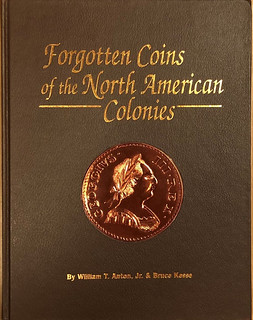
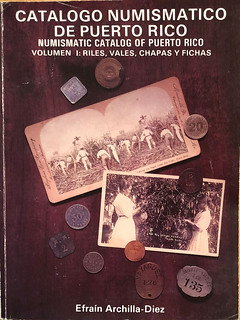
Lots 4025 and 4026
Lot 4025: Forgotten Coins of the North American Colonies
Anton, William T., Jr. and Bruce Kesse, Forgotten Coins of the North American Colonies, Krause Publications, Iola, 1992, 92 pages, 10 plates, hardcover. A catalog and classification system
for counterfeit English and Irish coppers that circulated in the North American colonies. Includes a few evasion pieces. Great photos, ex James Farr Collection Library.
To read the complete lot description, see:
Anton, William T., Jr. and Bruce Kesse. Forgotten Coins of the North American Colonies
(https://www.sarc.auction/Anton-William-T-Jr-and-Bruce-Kesse-Forgotten-Coins-of-the-North-American-Colonies_i39432825)
Lot 4026: Numismatic Catalog of Puerto Rico
Archilla-Diez, Efrain, Catalogo Numismatico de Puerto Rico / Numismatic Catalog of Puerto Rico: Volume I, Riles, Vales, Chapas y Fichas, San Juan, 1990, 360 pages, softcover, numbered 439 or
500 copies, covers Puerto Rican "riles", "tokens", "vales" and "chapas" with estimated price guide. Includes additional listings sorted by town and type of coin, besides counterfeits,
Spanish and English text.
To read the complete lot description, see:
Archilla-Diez, Efrain. Catalogo Numismatico de Puerto Rico / Numismatic Catalog of Puerto Rico: Volu
(https://www.sarc.auction/Archilla-Diez-Efrain-Catalogo-Numismatico-de-Puerto-Rico-Numismatic-Catalog-of-Puerto-Rico-Volu_i39432826)
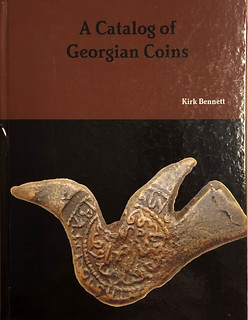
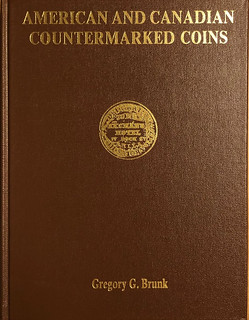
Lots 4052 and 4072
Lot 4052: A Catalog of Georgian Coins
Bennett, Kirk, A Catalog of Georgian Coins, Santa Rosa, 2014, hardcover, 341 pages, the new standard reference for coins of Georgia across all time periods including; Ancient Coins,
Georgian-Sasanian Coins, Arab Dynasties, Early Bagratid Coinage, The Golden Age of Georgia, Georgia under the Mongols, West Georgian Coinage (Kirmaneuli), Medieval Reduced Coinage, Persian
and Ottoman Coinage, Ottoman Occupation, Georgian Civic Coppers, Sirma Abazis, Russo-Georgian Coins, with Abbreviations chart, Bibliography, plus two appendixes: countermarks on Georgian
coins and reading the dates and mints of Mongol-Era coins, ex James Farr Numismatic Library.
To read the complete lot description, see:
Bennett, Kirk. A Catalog of Georgian Coins
(https://www.sarc.auction/Bennett-Kirk-A-Catalog-of-Georgian-Coins_i39432852)
Lot 4072: American and Canadian Countermarked Coins
Brunk, Gregory, American and Canadian Countermarked Coins, Rockford, 1987, World Exonumia Press, First Edition, 349 pages, hardcover, this is the most useful reference on the subject of
counterstamped / countermarked merchant coins by far.
To read the complete lot description, see:
Brunk, Gregory. American and Canadian Countermarked Coins
(https://www.sarc.auction/Brunk-Gregory-American-and-Canadian-Countermarked-Coins_i39432872)

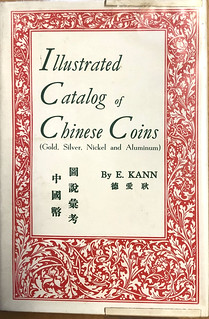
Lots 4110 and 4223
Lot 4110: German Secular Talers
Davenport, John Stewart, German Secular Talers, 1600-1700, Frankfurt am Main 1976, Numismatischer Verlag P.N. Schulten, Germany, crowns, 17th c., 588 pages, hardback, gray pseudo, illustrations in text, ex Norman D. Nicol Library.
To read the complete lot description, see:
Davenport, John Stewart. German Secular Talers, 1600-1700
(https://www.sarc.auction/Davenport-John-Stewart-German-Secular-Talers-1600-1700_i39432910)
Lot 4223: Illustrated Catalog of Chinese Coins
Kann, Eduard, Illustrated Catalog of Chinese Coins, Riverdale, 1966, 476 pages, 224 plates, hardcover with dust jacket in good condition, reprint of 1954 original. The flagship work on Chinese coinage written by the doyen himself. Still the single best reference on Chinese coins available anywhere and the long-time standard in-depth work on gold, silver, nickel. More historical information and depth of varieties than Krause. Still a much quoted reference work and a must for the collector of struck Chinese coinage, R, ex James Farr Numismatic Library.
To read the complete lot description, see:
Kann, Eduard. Illustrated Catalog of Chinese Coins
(https://www.sarc.auction/Kann-Eduard-Illustrated-Catalog-of-Chinese-Coins_i39433023)
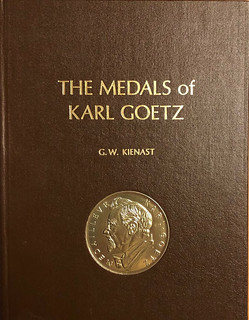
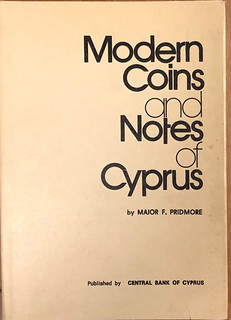
Lots 4228 and 4349
Lot 4228: The Medals of Karl Goetz
Kienast, Gunter. W., The Medals of Karl Goetz, Artus Company, Cleveland, Ohio, 1967, reprinted 1980, 284 pages, hardcover. The standard reference on political, satirical and historical medals of Karl Goetz covering the period 1914-1945 with superb photographs. During his 40 years as a medalist, Goetz produced a total of 633 medals. Text in English, ex James Farr Numismatic Library.
To read the complete lot description, see:
Kienast, Gunter. W. The Medals of Karl Goetz
(https://www.sarc.auction/Kienast-Gunter-W-The-Medals-of-Karl-Goetz_i39433028)
Lot 4349: Modern Coins and Notes of Cyprus
Pridmore, F., Modern Coins and Notes of Cyprus, Central Bank of Cyprus, Nicosia, 1974, 323 pages, hardcover with dust jacket. Coins and banknotes of Cyprus during British Colonial times. Contains an in-depth history of the coinage with Pridmore's usual detail of the individual coins, ex James Farr Collection Library.
To read the complete lot description, see:
Pridmore, F. Modern Coins and Notes of Cyprus
(https://www.sarc.auction/Pridmore-F-Modern-Coins-and-Notes-of-Cyprus_i39433149)
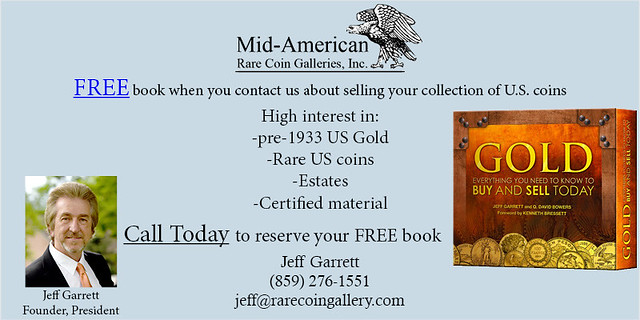
NEW BOOK: COINS OF THE ROMAN REVOLUTION
A new book has been published on the coins of the Roman revolution. -Editor
 Coins of the Roman Revolution, 49 BC-AD 14
Coins of the Roman Revolution, 49 BC-AD 14
Evidence Without Hindsight
Edited by Anton Powell and Andrew Burnett and contributions by Lucia F. Carbone, Hannah Cornwell and Guillaume de Méritens de Villeneuve
Coins of the best-known Roman revolutionary era allow rival pretenders to speak to us directly. After the deaths of Caesar and Cicero (in 44 and 43 BC) hardly one word has been reliably transmitted to us from even the two most powerful opponents of Octavian: Mark Antony and Sextus Pompeius - except through coinage and the occasional inscription. The coins are an antidote to a widespread fault in modern approaches: the idea, from hindsight, that the Roman Republic was doomed, that the rise of Octavian-Augustus to monarchy was inevitable, and that contemporaries might have sensed as much.
Ancient works in other genres skilfully encouraged such hindsight. Augustus in the Res Gestae, and Virgil in Georgics and Aeneid, sought to flatten the history of the period, and largely to efface Octavian's defeated rivals. But the latter's coins in precious metal were not easily recovered and suppressed by Authority. They remain for scholars to revalue. In our own age, when public untruthfulness about history is increasingly accepted - or challenged, we may value anew the discipline of searching for other, ancient, voices which ruling discourse has not quite managed to silence.
In this book eleven new essays explore the coinage of Rome's competing dynasts. Julius Caesar's coins, and those of his `son' Octavian-Augustus, are studied. But similar and respectful attention is given to the issues of their opponents: Cato the Younger and Q. Metellus Scipio, Mark Antony and Sextus Pompeius, Q. Cornificius and others. A shared aim is to understand mentalities, the forecasts current, in an age of rare insecurity as the superpower of the Mediterranean faced, and slowly recovered from, division and ruin.
About the Author
Anton Powell has published extensively on the history of Sparta, Athens - and the literature of the Roman Revolution. His monograph Virgil the Partisan (CPW, 2008) was awarded the prize of the American Vergilian Society for `the book that makes the greatest contribution toward our understanding and appreciation of Vergil'. He has twice been Invited Professor at the Ecole Normale Supérieure in Paris, in 2006 for Greek history and in 2008 for Latin literature -- Andrew Burnett was Deputy Director of the British Museum from 2002 to 2013, having begun his career in the Coins and Medals department. His distinctions include the Silver Medal of the Royal Numismatic Society, the Jeton de Vermeil of the French Numismatic Society and the Huntington Medal of the American Numismatic Society. He was appointed a CBE by the Queen in the New Year's Honours of 2012, and is an Honorary member of the Royal Belgian Numismatic Society, the International Numismatic Council and the French Numismatic Society (2105, 2016). He has been the President of the Royal Numismatic Society, the Roman Society and the International Numismatic Commission. His publications include volumes in the series Coin Hoards from Roman Britain; Coinage in the Roman World, and his major collaborative work is Roman Provincial Coinage Volumes I-III.
For more information, or to order, see:
Coins of the Roman Revolution, 49 BC-AD 14
Evidence Without Hindsight
(https://www.bloomsbury.com/uk/coins-of-the-roman-revolution-49-bc-ad-14-9781910589762/)
In the USA:
Coins of the Roman Revolution, 49 BC-AD 14
Evidence Without Hindsight
(https://www.isdistribution.com/BookDetail.aspx?aId=103135)

NEW BOOK: THE UNUSUAL SUSPECT
While non-numismatic, the topics of treasure finds and bank robbers are often of interest. Crimereads published an excerpt of a new book on a modern "Robin Hood" bank robber. -Editor
 The name of the young man in the interview room at Vermont’s Southern State Correctional Facility was Stephen George Dennis Jackley. He was twenty-two years old and came from a small town called Sidmouth on the South Devon coast. He was a geography student at the University of Worcester. As a rule, geography students from Devon do not tend to find themselves consigned to the Hole. Or known to Interpol. Or being interrogated by a pair of U.S. federal agents. Or, for that matter, being the subject of a multiagency, multinational criminal investigation. But Stephen Jackley was not like most geography students.
The name of the young man in the interview room at Vermont’s Southern State Correctional Facility was Stephen George Dennis Jackley. He was twenty-two years old and came from a small town called Sidmouth on the South Devon coast. He was a geography student at the University of Worcester. As a rule, geography students from Devon do not tend to find themselves consigned to the Hole. Or known to Interpol. Or being interrogated by a pair of U.S. federal agents. Or, for that matter, being the subject of a multiagency, multinational criminal investigation. But Stephen Jackley was not like most geography students.
This was not the first time Special Agent Scott Murray had encountered Stephen. He had interviewed him some months earlier, on the afternoon of his arrest in May 2008. Since then, Murray had been liaising with British detectives on a case. “I do a lot that involve firearms and explosives,” he says. “Every case is different, but this one is memorable. I guess that’s the best way to put it.”
Stephen Jackley had, like many young people, looked around and concluded that the world was not fair. And like many young people, he’d wanted to make a difference. It’s just that, rather than going on protest marches, involving himself in politics, or running sponsored marathons, Stephen ended up robbing banks. Over a seven-month period in 2007 and 2008, he struck repeatedly and successfully. “You could not expect an educated person in his early twenties to commit a series of armed robberies across the country and internationally,” said one British detective, speaking to the press after his eventual capture. “It has been a complex and protracted investigation.”
Special Agent Murray had spent enough time with the young man in front of him to judge that he was both intelligent and about as far from a typical bank robber as you could get. But there was something about him that he still struggled to understand, a side of his character that remained elusive and was hard to associate with the high-security surroundings they both now shared. He was calm, quiet, incongruous. Murray frowned. “I never felt I got a full scope of who he is.”
One thing that struck everybody, though, was Stephen’s unusual habit of writing everything down. As British and American investigators dug into the evidence surrounding his case, it had become clear that Stephen had what seemed a compulsive need to commit his thoughts and deeds to paper. Everything he planned, he wrote down. Everything he did, he reflected on in his diaries—page after page after page filled in his careful, steady handwriting. “He was methodical in the way he wanted to write down what he wanted to do in the future and what he had done in the past,” says Murray.
Back in the interview room at SSCF, the austere gray-haired agent explained to Stephen what the FBI was and what they did. In a deep, measured voice he said that the agency was helping British police with their investigation into his crimes. He produced a pile of photocopied papers covered in writing, numbers, dates, and strange codes. He sifted through them slowly and deliberately, found what he was looking for, and slid it across the table. It was a photocopy of a British banknote with the letters “RH” scrawled on it. The FBI man glanced at Murray. Could Stephen tell them, he asked, what it means? Stephen glanced at it. And he nodded.
To read the complete article, see:
THE BRITISH STUDENT-TURNED-BANK ROBBER WHO BECAME "A MODERN-DAY ROBIN HOOD"
(https://crimereads.com/the-british-student-turned-bank-robber-who-became-a-modern-day-robin-hood/)
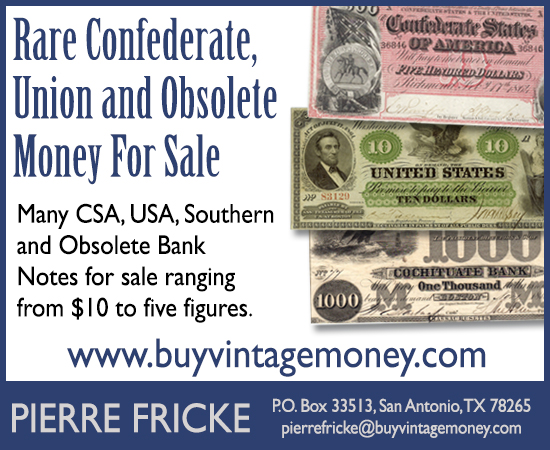
THEODORE HENRY YOUNG (1936-2021)
Dealer Ted Young of Western Pennsylvania has passed. -Editor
 Theodore Henry Young of Chippewa Twp. passed away at 84 on Thursday, January 7, 2021 in Select Specialty Hospital-Boardman in Youngstown, OH.
Theodore Henry Young of Chippewa Twp. passed away at 84 on Thursday, January 7, 2021 in Select Specialty Hospital-Boardman in Youngstown, OH.
Born January 26, 1936, on a 111-acre farm in Chippewa, Ted built his strong work ethic helping his family on the homestead while attending Beaver Falls High School. After graduating, he joined the Army, then worked for his aunt and uncle at Reed’s Dairy. He started his own milk delivery business with his brother, Dave in 1964. Over a decade they grew their delivery route from 7 families to over 1,100.
It was during his success in the milk business that he discovered his passion-coin collecting. What started as a hobby turned into a flourishing business after Ted purchased the former First National Bank of Rochester building and turned it into Young’s Jewelry and Coins in 1974.
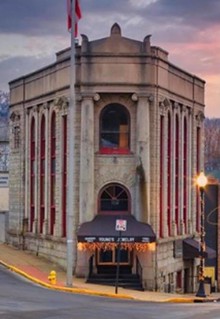 Alongside his wife and three sons, Ted built a family business that was more than your typical jewelry store. He loved the history of coins and currency. One of his most prized collections were the first notes issued by the Beaver and Rochester national banks. While Ted never retired, he was quick to express how proud he was to leave the business to his sons. His family, friends, employees and customers alike admired his generosity, honesty and intelligence.
Alongside his wife and three sons, Ted built a family business that was more than your typical jewelry store. He loved the history of coins and currency. One of his most prized collections were the first notes issued by the Beaver and Rochester national banks. While Ted never retired, he was quick to express how proud he was to leave the business to his sons. His family, friends, employees and customers alike admired his generosity, honesty and intelligence.
Known for his spontaneity, Ted once bought 5,000 pocket watches at a coin show. The watches filled the counters at Young’s Jewelry only long enough for a customer from Buffalo to visit the store and buy every single one. He packed his pocket watches into 5-gallon buckets and it took him 18 full buckets to carry his purchase out of the shop.
Besides his business success, Ted was a pillar of the community. A quietly generous philanthropist, Ted helped raise money for various causes during his life, including the American Cancer Society, Life Steps, victims of Hurricane Dorian, and anyone who needed a helping hand. He was proud to fly the tallest American flag in Beaver County above Young’s Jewelry. A huge fan of the Blackhawk basketball teams, Ted would travel by limo to the state championships in Hershey and gift both the boys’ and girls’ teams with watches for winning.
Alongside his renowned work ethic, Ted was also a man who loved relaxing with his family in his house on the island of Eleuthera in the Bahamas. He was well-loved by his friends who called him T.H. and Teddy, with many of his friendships spanning more than 40 years.
He was preceded by his wife, Pauline (Kirchel); his son, Ricky; and his brother, David.
Surviving are his two sons, Jeffrey and Timothy of Chippewa; his favorite daughter-in-law, Jeff’s wife, Cyndi (Chapman); his brother, Wayne (Barb) Young; his brother-in-law and two sisters-in-law, Ed and Marilyn Kirchel and Bonnie Young; Loving grandfather to Michelle, Ryan, and Shelby. Doting great-grandfather to Ky’zier and Khalil.
To read the complete article, see:
Theodore Henry Young
(https://www.gabauerfamilyfuneralhomes.com/obituary/Theodore-Young)
For more information, see:
https://www.youngscoinandjewelry.com/
https://www.facebook.com/Youngs-Jewelry-Coins-138932509459912/
Larry Korchnak writes:
"I knew Ted for nearly 50 years, and, in the early days he focused on jewelry, bullion and United states coins. His shop occupied the site of the former Rochester National Bank so it had a walk-in vault where he kept his extensive stock. (There was a magnificent ornate brass railing on the edge of the balcony where his wife Pauline often worked at a desk. He was once offered $10,000 for it but declined because he said that it was part of the character of the classic structure.) Ted’s customer base was varied and I often searched through buckets of world coins as he was putting the final touches on a big deal over the phone. I guess that I became a trusted client when I pulled out an AU Virginia colonial half cent from a hodgepodge of foreign coins and told him and his son Rick that it was in the wrong bucket! After that, when I wanted to look though his world coins, I was often told to just go into the vault and see what he had.
I could share a hundred stories about my visits to Ted’s coin shop over the years but one really stands out. I was rummaging through a collection of world coins when one his more distinguished customers entered the shop to show off his most recent acquisitions. He was a well-known contractor who had successfully bid on four U.S coin rarities. The customer took out a coin wallet and proudly held out uncirculated Panama Pacific octagonal and round $50 gold pieces. Then he produced a magnificent mint state St. Gaudens 1907 wire rim high relief $20 gold. As I was thinking how fortunate I was to have opportunity to examine these classic rarities close up, the man pulled out a proof $4 stella! Ted just smiled as if were just another typical afternoon in Rochester, Pennsylvania."
Tom Uram writes:
"Ted Young was truly a dealer's dealer. Ted was a mentor to many who took on the profession of numismatist. He would also take as much time as he could with collectors.
"As president of PAN, I could always count on Ted for donations and buying raffle tickets. He knew that it all went to our educational outreach. For years Ted was famous for bringing to the PAN show, dozens of 5 inch cinnamon rolls that he shared with dealers and friends. They would be gone in no time flat.
"Ted was a personal friend, he will truly leave a void in Western PA."
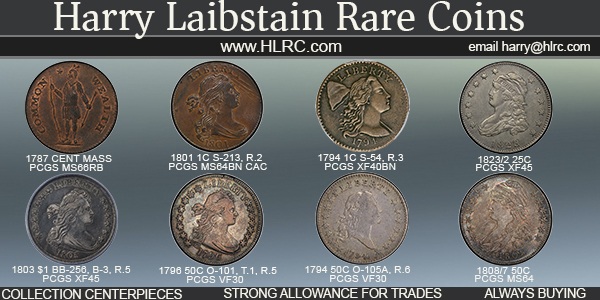
NEWMAN PORTAL ADDS PAPER ON C. WYLLS BETTS
The latest addition to the Newman Numismatic Portal is a paper about author C. Wylls Betts. Project Coordinator Len Augsburger provided the following report. Thanks. -Editor
Newman Portal Adds Paper on C. Wylls Betts
 Following up on the Betts’ biography appearing in the January 10th E-Sylum, Chris McDowell contributed an in-depth exploration of the identity of Mrs. Charles Wyllys Betts, said to have been married to Betts from 1879-1880. As part of a Newman Grant, awarded in May 2020 for the purposes of numismatic research, McDowell has been working on the subject of Fugio cents and Betts’ involvement with the Fugio restrike dies. The discovery of Betts papers at the Morgan Library in New York demanded further investigation, and, in this paper, McDowell delivers convincing evidence that in fact “Mrs. Charles W. Betts” never existed, and that references to her actually refer to Betts’ sister-in-law Louise (Holbrook) Betts.
Following up on the Betts’ biography appearing in the January 10th E-Sylum, Chris McDowell contributed an in-depth exploration of the identity of Mrs. Charles Wyllys Betts, said to have been married to Betts from 1879-1880. As part of a Newman Grant, awarded in May 2020 for the purposes of numismatic research, McDowell has been working on the subject of Fugio cents and Betts’ involvement with the Fugio restrike dies. The discovery of Betts papers at the Morgan Library in New York demanded further investigation, and, in this paper, McDowell delivers convincing evidence that in fact “Mrs. Charles W. Betts” never existed, and that references to her actually refer to Betts’ sister-in-law Louise (Holbrook) Betts.
McDowell cites a contemporary record from the American Numismatic Society noting that Charles Betts never married, and further explains how a cataloging error at the Morgan Library turned into a person who never existed. McDowell intends to continue his research in Manchester (UK), working with the Matthew Boulton papers to investigate the involvement of Boulton and James Jarvis with the Fugio cents.
Image: Call slip from the Morgan Library, requesting Betts letters from the Arthur Sullivan papers
Link to “The Late Mrs. C. Wyllys Betts of New York City: Another Numismatic Mystery Put to Rest” on Newman Portal:
https://nnp.wustl.edu/library/booksbyauthor/534073
Link to “Charles Wyllys Betts (1845-1886)” in the January 10th, 2021 E-Sylum:
https://www.coinbooks.org/v24/esylum_v24n02a23.html
THE BOOK BAZARRE
ANA TRIVIA ANSWER: J. A. HECKELMAN
Pete Smith submitted this answer to the question he posed last week: Who was the person who served as First Vice President for the ANA during 1899-1901?. Thanks! -Editor
Last week I posed the question: Who served as ANA First Vice President during 1899-1901?
A good answer would be J. A. Heckelman. That is the way his name appears in The Numismatist about 50 times. He is listed as an officer but little else is said about him. He is listed with membership number 5 in 1905.
A bad answer would be John A. Heckelman. An 1895 article gave his name as “John A, Heckelman, Virginia.” Another article in 1904 gave his name as “John A. Heckelman.” The name has gone into the history of the ANA as John A. Heckelman.
While searching for biographical information, I came across John A. Heckelman in Cullom, Illinois. He was born in 1828 and died in 1875 so his span of life does not fit. However, he had a son named James.
James A. Heckelman was born in Cullom, Illinois, on October 29, 1862. He was married to Nellie Lee Baker (1864-1935) on May 13, 1886. Their children were Lena Margaret Mowery and Thelma Evangeline Brown. James died at Cullom on January 4, 1933.
Cullom was a small town with a 1900 population of 456. At that time, James was living with his mother, wife, daughter and a servant. The 1910 Census gives his profession as real estate agent.
Thus. it appears more likely to me that J. A. Heckelman was really named James and that James A Heckelman is the best answer to the trivia question.
To read the earlier E-Sylum article, see:
NOTES FROM E-SYLUM READERS: JANUARY 10, 2021 : ANA Trivia Question: First Vice President 1899-1901
(https://www.coinbooks.org/v24/esylum_v24n02a19.html)

RICHARD LOBEL ON HANS AND JACQUES SCHULMAN
London dealer Richard Lobel submitted these remembrances of fellow dealers Hans and Jacques Schulman. Thank you! -Editor
Hans and Jacques Schulman
As I knew both of them quite well, I would like to submit my memories of both of them. Perhaps your readers might enjoy a trip in the past.
Yes, they were related but they were as they say in Britain, like chalk and cheese. But then again if you have 200 dealers in a room, they will do things in 200 different ways. Each will think they are correct and most will earn a living. Coin dealers are different from real people.
Let me introduce myself. My name is Richard Lobel, I was born in Boston, Mass but moved to London, England 52 years ago. I founded and own Coincraft – Britain’s Coin Shop. I have travelled all over the world in pursuit of coins and banknotes and used to average 250,000 kilometres a year in the air. I have been listed 14 times in the Guinness Book of World Records. I own one of Britain’s oldest and largest coin dealers, which only deals with collectors and we sell nothing as an investment. We publish The Phoenix every three weeks, as well as The BlueCard Flyer. Each year we publish in excess of 40 numismatic catalogues all in full colour for collectors. I have been privileged over the years to know and even call friends some of the most interesting dealers in coins and banknotes from all over the world. I saw in E-Sylum a note about the Schulmans and wanted to add my remembrances.
Jacques ran an old fashioned numismatic company which reflected the history of the firm and its handsome location. It is still my ideal of a coin dealer, what a real coin dealer should look like. I would get off at the airport, jump into a taxi and ask for number 448. As I would usually try to visit two or three countries in as many days, speed was of the essence. Once I became known to Schulman, by making repeated visits, I was given free reign of the safes, including the medallion cabinets in the hallway. Mrs. Schulman would come up to say hello from downstairs, where she ran the antiquities department. I would then go from safe to safe, hoping to find something special or even a bargain.
Being allowed to go through the safes I often found interesting coins that I wouldn’t have known to ask for. They used circular tickets to write up their coins and every time they raised a price, they would clip off the old price. Some of their tickets looked like cog wheels with all their price changes. Personally I would have used a pencil. When they had a new group or hoard, they would allow you to buy one or perhaps two pieces, but that was the limit. On a personal basis, I loved the long wall of medallion cabinets in the hallway, stacked up so high that some were difficult to look in. I love medallions, because the engraver has so much more space and scale to work with. And they commemorate current events even when those events were hundreds of years old. Like a kid in a candy shop I was.
Their auctions were legendary and in true European fashion the bidders were extremely well looked after. The tables in the auction room, no single chairs for them, were stacked with bottles of water and other drinks. They held dinners to entertain the bidders in the evenings. The younger dealers, such as myself, were taken out to where the younger people met. After all, they realised that today’s young dealer is tomorrow's established dealer. They were old fashioned but they always did it with class and style. I will always remember Jacques smoking his small cigars and the ash falling on his vest, smiling as a deal was agreed. He was my ideal coin dealer.
I loved Hans, although I only got to really know him and his wife Zita when they moved to Spain. I had met and knew him, but we had never done that much business. Whenever they would come to London, we would always have dinner together. It was something I looked forward to. Anyone who knew Hans was aware of what a great storyteller he was, making those dinners an event. He was always so cheerful, the glass was always half full, even when things were not at their best. I never knew his New York business, but believe that it was based on both an office and auctions. The auctions were famous or infamous for their freedom of descriptions. He had a way with words. One auction that I will always remember had this very long paragraph describing a rare coin, ending the description with the word ‘Unique’. The next lot read ‘another the same’ ‘Unique’ as did the two following lots.
He had a number of ex-wives to whom he was paying alimony. His auctions were a delight not only because of their content but also because of the deals he did with the owners. He did some fantastic auctions of odd and curious money as well as ancient coins for collectors, they were classics. The question was asked about why he left America, I think I can answer that.
Hans, because of his constant need for money to pay his ex-wives, got conned by a con man. There is a book out that covers most of this, with Han’s identity lightly hidden. His being conned took just one chapter, but put an end to his business. The con man took over the company, promising Hans a chance to make real money. He re-named it Schulman Coin and Mint and then sold shares to the public, playing on The Franklin Mint success. From what I understand they were using Han’s knowledge to write the coins up and then the con man would greatly enhance the retail prices and use the newly priced coins for collateral at the bank. They were able to borrow a fixed percentage of the retail price from the bank. I am not sure that they were even interested in selling coins. More money was to be made from selling shares and borrowing money from the bank. When it all went wrong, within a year or two, they found out that the inventory was greatly and I do mean greatly inflated. I know someone who bought some of the inventory from the auction. I believe he paid 5% of the so-called ‘retail’, even then he paid too much.
Everyone lost money and Hans, while not guilty of any wrongdoing, felt it was easier to retire to Spain. After all as a European, even after that many years in America he was still a European. Spain was chosen because of the nice weather, inexpensive cost of living and the freedom it provided. Hans is of course best known for his being King Farouk of Egypt’s coin dealer. I never knew him at that time, but many years later I bought some of the dies from him that he had used to strike coins for Farouk. But that as they say is another story.
He once saved my hide when I made a serious error. I had bought a group of the crown-sized German patterns struck by Goetz. There were I think, six pieces but they were piedforts in gold and as such extremely rare. Without checking I assumed that they were ex-King Farouk. I sold them to an overseas collector, telling him that they were ex-Farouk. Later he got a copy of the famous Farouk auction catalogue and these pieces were not listed. The sale I had made was for $20,000 which was a hell of a lot of money at the time. Being young I had already flittered the money away. Making a refund very difficult. Hans got me out of that problem, but that again is another story as they say.
I am both proud and honoured to have known both Schulmans. Both were an important part of our numismatic history and both were gentlemen. Today’s dealers are so boring compared to the old school…
To read the earlier E-Sylum article, see:
NOTES FROM E-SYLUM READERS: JANUARY 10, 2021 : Jeff Zarit on Hans and Jacques Schulman
(https://www.coinbooks.org/v24/esylum_v24n02a19.html)
To visit the website of Richard's CoinCraft, see:
https://www.coincraft.com/

MORE DUAL IMAGE OPTICAL ILLUSIONS IN METAL
Regarding hidden images in coin designs, Paul Horner writes:
"Here is an aluminum dollar size token of the late Leon Hendrickson. I believe the obverse was also used on Mardi Gras tokens. (Hint: examine "Leons's profile closely)"
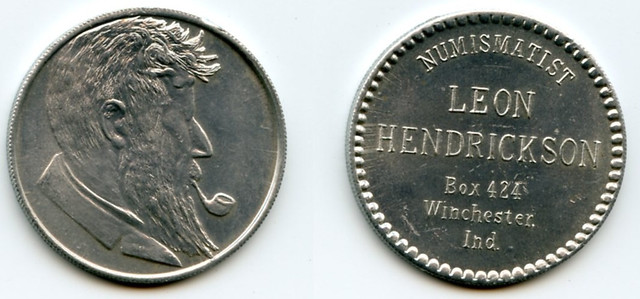
Thanks! Cleverly done. -Editor
George Kolbe writes:
"There is even a quite scarce and sought-after book on one aspect of the genre, anti-papal medals.
"Barnard, Francis Pierrepont. Satirical and Controversial Medals of the Reformation: The Biceps or Double-Headed Series?. Oxford: At the Clarendon Press, 1927. (6), 45, (3) pages, a few text figures, 6 fine plates."
Thanks. I found some examples of the medals online. -Editor
Satirical Medal
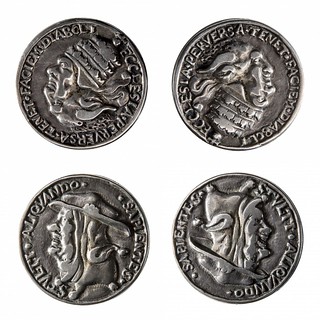 Medals were a popular propaganda medium during the religious conflicts in the 16th century. The biceps series was particularly common. Our example depicts a double headed Pope-Devil on the obverse and a cardinal-fool on the reverse. The legends emphasize the medal’s message: ECCLESIA PERVERSA TENET FACIEM DIABOLI (The Church perverted has the face of the Devil) and STVLTI ALIQVANDO SAPIENTES (The fools are sometimes wise). The Pope is thus put on the same level with the Devil, the cardinal with a fatuous fool. The creation of this medal can be linked to the conflict surrounding the nomination of Nicolaus von Amsdorf, one of Luther’s most determined supporters, as bishop of Naumburg in 1542.
Medals were a popular propaganda medium during the religious conflicts in the 16th century. The biceps series was particularly common. Our example depicts a double headed Pope-Devil on the obverse and a cardinal-fool on the reverse. The legends emphasize the medal’s message: ECCLESIA PERVERSA TENET FACIEM DIABOLI (The Church perverted has the face of the Devil) and STVLTI ALIQVANDO SAPIENTES (The fools are sometimes wise). The Pope is thus put on the same level with the Devil, the cardinal with a fatuous fool. The creation of this medal can be linked to the conflict surrounding the nomination of Nicolaus von Amsdorf, one of Luther’s most determined supporters, as bishop of Naumburg in 1542.
https://www.reforc.com/rare-reformation-relics-item/satirical-medal/

Description
Silver medal. (whole)
The Pope's head and the Devil's joined in one face. (reverse)
Bust of Sir Edmundbury Godfrey, right, hair long, in falling lace collar, doublet buttoned, and mantle over shoulders; two hands strangling him with his cravat. (obverse)
Producer name
Designed by: George Bower
Production date
1678
https://www.britishmuseum.org/collection/object/C_G3-IP-1011
To read the earlier E-Sylum article, see:
NOTES FROM E-SYLUM READERS: JANUARY 10, 2021 : The Man in the Hairdo
(https://www.coinbooks.org/v24/esylum_v24n02a19.html)
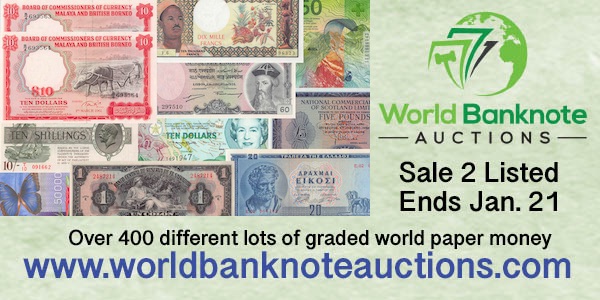
NOTES FROM E-SYLUM READERS: JANUARY 17, 2021
My Neighbor, Hans Schulman
Bob Steinberg writes:
"Just as a fun fact when I lived in NYC in the 1960's and had a shop down the street from Lester Merkin (our address was 137 E. 56th st) Hans Schulman lived in the same apartment complex on the west side of Manhattan called "Lincoln Towers" (located near Lincoln Center). I used to see him from time to time in our neighborhood. The other famous resident of our complex was Henny Youngman, the old time comedian famous for the line "take my wife---PLEASE!"
More on David Fiero
Alan Luedeking writes:
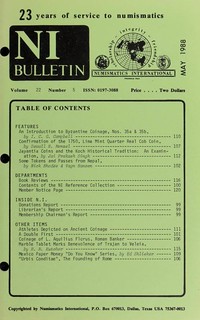 "One more thing about David B. Fiero: He was a valuable contributor to
the Numismatics International Bulletin in the form of excellent articles
and book reviews."
"One more thing about David B. Fiero: He was a valuable contributor to
the Numismatics International Bulletin in the form of excellent articles
and book reviews."
Many back issues of the NI Bulletin are available on the Newman Numismatic Portal. To read some of Fiero's articles, see: https://nnp.wustl.edu/library/searchwithterms?searchterm=David%20B.%20Fiero -Editor
To read the earlier E-Sylum article, see:
DAVID FIERO (1950-2020)
(https://www.coinbooks.org/v24/esylum_v24n02a09.html)
Cheap-o Tip Turns Expensive
Gary Dunaier writes:
"The article about the "Zero Cents No-Tip Kookie Koin" made me think of the attached Dave Berg "Lighter Side" comic strip, which originally appeared in Mad Magazine (issue #119, June 1968)."
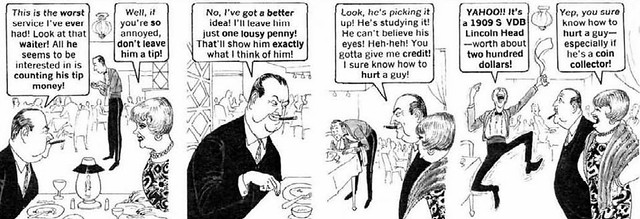
Thanks! -Editor
To read the earlier E-Sylum article, see:
ZERO CENTS NO-TIP KOOKIE KOIN
(https://www.coinbooks.org/v24/esylum_v24n02a28.html)
The Explorer's Refuge
Keith Scott of Milpitas CA writes:
"As I cleaned out magazines (looking at each page) this made me smile and dream. How can I add this to my house? I just retired as a Contractor/Craftsperson."
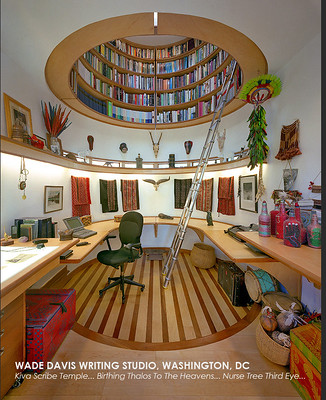
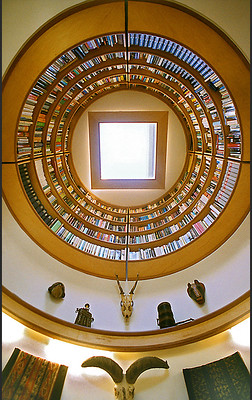
THE EXPLORER'S REFUGE
Architect Travis Price designed this studio for an anthropologist who travels the world collecting artifacts and taking photos for the books he writes. At home, he needed a sanctuary where he could write without distraction and be surrounded by his books, research, and inspirational touchstones. In a sense, the office was to be a structural metaphor for the writer's own mind.
Bibliophiles can certainly relate to this design, and everyone can dream of a nice, quite hideaway workspace. Thanks! Very nice. Keith provided a scan of the article from Fine Homebuilding Magazine and I located higher-resolution images on the architect's website. -Editor
To visit the architect's website, see:
https://travispricearchitects.com/

CELLPHONE PHOTOS TOOK OVER THE COIN MARKET
In a recent blog post, Doug Winter discusses "Numismatic Radiology: How Cellphone Photos Took Over the Coin Market in 2020". Here's an excerpt - see the complete article online. -Editor
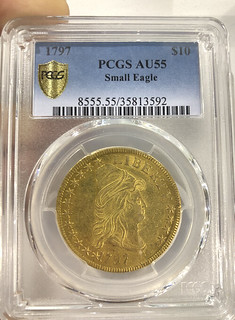 Beginning about three or four years ago, I noticed an ever-increasing amount of my business involved cellphone pictures of coins. This was especially true from the aspect of buying. And as the coin market had to re-invent itself in 2020 due to Covid 19, a significant amount of business became cellphone-driven. If I had to guess, I would say that close to 50%—if not more—of all dealer-to-dealer business is now done off of cellphone images.
Beginning about three or four years ago, I noticed an ever-increasing amount of my business involved cellphone pictures of coins. This was especially true from the aspect of buying. And as the coin market had to re-invent itself in 2020 due to Covid 19, a significant amount of business became cellphone-driven. If I had to guess, I would say that close to 50%—if not more—of all dealer-to-dealer business is now done off of cellphone images.
This is both great and terrible. The “great” part of the equation is that dealers found a viable way to quickly move new coins. The “terrible” part is that these transactions tend to be sight-unseen and unless a dealer is very sophisticated and knows how to read a cellphone image of a coin (and others factors as well) he is going to get stuck with some really low-end coins.
In the title of this blog, I referred to radiology and this is only partly a joke. Cellphone images of coins can be interpreted if you know what to look for, just as a radiologist uses medical imaging to diagnose and treat diseases.
Here are some tips which might make the next cellphone image you get a little easier to interpret.
1. Learn What Nice Coins Are Supposed to Look Like
In each of the books which I have written about branch mint gold, I take a lot of time describing what a “proper” example of a coin is supposed to look like. As an example, when describing the natural coloration for an 1851-O half eagle, I state “(it) is most often a medium to deep orange or green-gold.” If you are being offered an 1851-O half eagle and it is dark red, this is a good sign that the coin has been recolored and should be avoided.
Another important thing to know about each issue is its type of luster. Does a specific coin come frosty, satiny, dull or brilliant? Although luster may not show up well on a cellphone image, you can often determine whether it is impaired or not.
2. Does the Coin Show Evidence of a Cover-up?
A good cellphone image may reveal areas of haze or blotches of odd color which are indicative or something having been placed on the surfaces to cover up a scratch, some hairlines or even an area where a spot has been removed. Coins with any of these should be avoided.
3. Swirls in the Fields
From time to time, the grading services miss minor old repairs on coins. As an example there may be some subtle swirls in the fields which are indicative of a spot having been removed or a mark having been scratched off. Unfortunately, it is difficult to see the edge of a coin in its slab, let alone in an image, so you’ll likely not be able to see if your coin has had its edges smoothed or filed. But look at as much of the edge as you can see and search for dense scratches or an area where the color doesn’t match the rest of the coin.
To read the complete article, see:
Numismatic Radiology: How Cellphone Photos Took Over the Coin Market in 2020
(https://raregoldcoins.com/blog/2021/1/8/numismatic-radiology-how-cellphone-photos-took-over-the-coin-market-in-2020)

U.S. MINT INTRODUCES NEW SEVEN-CENT COIN
In the breaking news department, Arthur Shippee passed along this report on the new coin introduced by the U.S. Mint. Thanks! -Editor
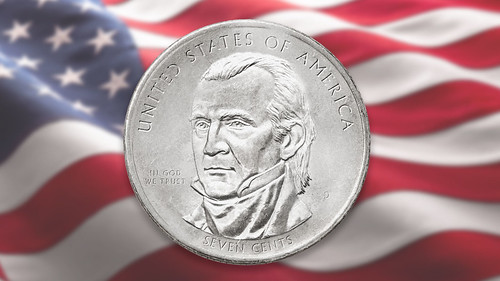
Explaining they were excited to “kick things up a notch,” officials from the U.S. Mint announced Friday a new seven-cent coin to bolster citizens’ math skills. “Let’s face it, we made it way too easy the first time,” said U.S. Mint Director David J. Ryder, who shared the bureau’s hopes that the new denomination, which would be called a ‘septi,’ would provide a greater challenge. “The nation has lagged behind other countries in terms of core addition, subtraction, and multiplication skills for years, but it’s not because we’re ‘stupid’ or bad at math—we just need a little practice. It’ll just require a little more focus next time you’re doing laundry or buying groceries. We believe in you guys. And don’t use a calculator, that just defeats the whole purpose.” At press time, Ryder added the U.S. Mint would also be introducing a new irrational number dollar bill next year, valued at the square root of 5, to help citizens brush up on their algebra.
Since we're nowhere near April 1, I feel obligated to point out that this of course, isn't true. It comes from the satirical publication The Onion. Here's a REAL seven-cent piece, a token from Richmond, VA, image courtesy Dave Schenkman. -Editor
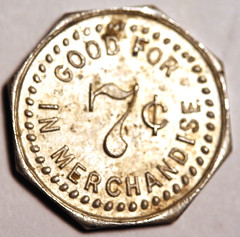

To read the complete article, see:
U.S. Mint Introduces New Seven-Cent Coin To Bolster Citizens’ Math Skills
(https://www.theonion.com/u-s-mint-introduces-new-seven-cent-coin-to-bolster-cit-1845108468)

THE CIRCULATING COLLECTIBLE COIN REDESIGN ACT
And here's a very impressive piece of real news from the U.S. Mint. Republished with permission from the Mint News Blog. Thanks. -Editor
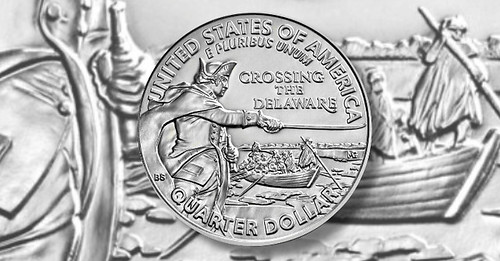
On January 13, 2021, President Donald Trump signed into law a bill known as the “Circulating Collectible Coin Redesign Act of 2020.” The bill was first introduced in the House of Representatives by Rep. Barbara Lee, D-CA, on March 27, 2020, and is quite comprehensive, affecting every circulating coinage denomination from the cent to the dollar over the next nine years, plus significant new medals and silver bullion coins.
Here is a summary of some of the changes the Circulating Collectible Coin Redesign Act of 2020 brings in the near future:
PROMINENT WOMEN
Coins involved: Quarter dollars, 2022–2025.
Directing the Treasury Department, through the U.S. Mint, “to mint and issue quarter-dollar coins in commemoration of the ratification of the Nineteenth Amendment granting women the right to vote. The design on the reverse of each coin shall be emblematic of the accomplishments and contributions of a prominent woman who was a resident of a state, the District of Columbia, or a U.S. territory.” Effective January 1, 2022, through the end of 2025, the Secretary of the Treasury “shall issue quarter dollars that have designs on the reverse selected in accordance with this subsection which are emblematic of the accomplishment of a prominent American woman.”
The act provides for up to five coins per year. Coins will feature one prominent woman on the reverse while maintaining George Washington’s likeness on the obverse and flexibility in the placement of inscriptions. Women depicted may be selected from fields and accomplishments such as “suffrage, civil rights, abolition, government, humanities, science, space, and arts.”
Dennis Tucker, publisher of Whitman Publishing (maker of the Guide Book of United States Coins, known as the “Red Book”) and numismatic specialist on the Treasury Department’s Citizens Coinage Advisory Committee, said:
"This new coin program is unique and exciting. It marks the first time Congress will use a series of circulating coins to honor prominent Americans. We’ve had popular quarters that celebrate the states and territories. We’ve had the National Park quarters. This program is different, and equally historic. It will honor not only people, but specifically American women, and the law mentions ethnic, racial, and geographical diversity. The opportunities are immense."
250 YEARS OF AMERICAN INDEPENDENCE
Coins involved: Cent, nickel, dime, quarter, half dollar, and dollar, 2026.
The issuance of redesigned circulating coins emblematic of the United States semiquincentennial (the 250th anniversary of the Declaration of Independence). Commencing on January 1, 2026, for a one-year period, the Treasury Secretary “may issue quarter dollars in 2026 with up to five different designs emblematic of the United States semiquincentennial.” One of the quarter dollar designs will be emblematic of “a woman’s or women’s contribution to the birth of the Nation or the Declaration of Independence or any other monumental moments in American History.” Also provided for are one-dollar coins emblematic of the United States semiquincentennial.
This section of the legislation also allows the Treasury to redesign, for the year 2026, every other circulating U.S. coin—the Lincoln cent, the Jefferson five-cent nickel, the Roosevelt dime, and the Kennedy half dollar.
“The importance of this coin redesign can’t be overstated,” said Tucker. “The 1776–1976 Bicentennial coinage opened the eyes of generations of Americans to the coins in their pocket change. The Bicentennial quarter in particular embodied the idea of ‘circulating commemoratives’ in a way that no other coins had to that point. People still save them when they get them in change today, more than forty years later! Coming in 2026, the complete floor-to-ceiling redesign of America’s coins has the potential to get millions of people looking at their small change again.”
NEW PORTRAITS IN 2027
Coins involved: Quarter dollar and half dollar, 2027 and beyond.
Significantly, the Semiquincentennial section states that in 2027 the quarter and half dollar will bear likenesses of George Washington and John F. Kennedy, respectively—but not necessarily the original 1932 and 1964 likenesses by John Flanagan and Gilroy Roberts.
“This opens up the possibility of new portraits on two American coins, including the workhorse of U.S. circulating coins, the quarter dollar,” said Tucker. “Collectors are used to seeing new reverse designs come out in recent years. But new obverse portraits? That’s a game changer.”
YOUTH SPORTS
Coins involved: Quarter dollar and half dollar, 2027–2030.
The issuance of redesigned quarter dollars and half dollars emblematic of sports played by American youth. Effective January 1, 2027, through the end of 2030, quarter dollars will feature a single sport on each coin, with up to five coins per year.
At the same time, half dollars will follow similar design specifications, with their sports themes focused specifically on Paralympic sports (those tailored to athletes with a range of disabilities, including physical impairment, vision impairment, and intellectual impairment). These will be issued one per year.
“If you have kids or grandkids, you know how big this coin program will be,” said Tucker. “Millions of American children are involved in organized sports. With 20 coins in the quarter dollar series, the hunt will be on. I can imagine kids searching their piggy banks and trading with their friends for the coins they need. This will be another coin program that excites collectors for generations to come. The half dollar program is a nice touch, as well—a way to include young athletes of all abilities. Kudos to Congress for taking this direction.”
SPORTS MEDALS
Coins involved: None directly, but potentially attached to every quarter and half dollar, 2027–2030.
For every design issued for the Youth Sports quarters and half dollars, the Mint can design and issue a medal (or multiple medals) for the sport involved. Sales of these medals can be used to fund the designing and manufacturing of Olympic medals (see below).
“Medals give the Mint’s artists even more creative leeway than coins do,” said Tucker. “As a medal collector myself, I look forward to seeing the great artwork that comes out of this program. A couple aspects to watch for: Congress in this legislation anticipates that the medals will be struck in high relief, and, if it’s affordable, with surface treatments such as frosting and colorization.”
OLYMPIC MEDALS
Coins involved: None (medals).
The legislation authorizes the Secretary of the Treasury to design and manufacture medals for award at the 2028 Olympic Games in Los Angeles, California.
“This is another historic part of the Coin Redesign Act,” said Tucker. “Other nations in recent years have struck the medals awarded at the Olympic Games. This would be a first for the United States Mint. We can expect to see outstanding artistry if this comes about.”
FIVE-OUNCE AND FRACTIONAL SILVER BULLION COINS
Coins involved: Quarter dollar and half dollar.
Some coins involved in the Redesign Act can be struck in three-inch diameter with a weight of five ounces of .999 fine silver. The quarter dollars and half dollars can also be issued in “fractional” sizes of silver bullion coins with the same designs.
“With this law, Congress gives the Secretary of the Treasury authority to make these bullion coins,” Tucker said. “We’ll have to wait and see what decisions the Secretary makes, but it seems likely we’ll have a new suite of silver bullion coins in the near future. Collectors have bought tens of thousands of the five-ounce America the Beautiful silver coins every year, and these programs should be as popular, if not more so. Not to be overlooked: smaller silver coins would be another fresh innovation in American bullion.”
MARKETING AND OTHER ASPECTS
The legislation encourages the Treasury to develop and include unifying inscriptions, privy marks, or other symbols in the coin programs involved. It also specifically mentions efforts to advance the collecting of the coins and medals, and to promote numismatics. To those ends, “the Secretary may develop and execute a marketing, advertising, promotional, and educational program” and “seek out appropriate cooperative marketing opportunities.” The law authorizes the Secretary to “develop ancillary derivative products beyond traditional numismatic products such as sports, women, and youth-oriented products.”
“This authorization of a marketing and educational campaign shows that Congress is serious about using coins to educate people about American history and culture,” Tucker said. “It also gives teeth to the Mint’s work in promoting coin collecting. The numismatic community will be very happy with this, and it will likely bring many new collectors into the hobby.”
“The effects of this Coin Redesign Act will be broad and far-reaching,” Tucker said. “It creates bold new coin series that should be very popular. It opens the doors to innovative new medals from the United States Mint. It also has some interesting side effects—for example, it will effectively turn the ‘Washington Crossing the Delaware’ quarter into a single-year type, of 2021. Overall, this is one of the most important and promising pieces of coinage legislation passed in modern memory.”
That's an amazing amount of new circulating coins. The bicentennial coins were popular, and I'll look forward to seeing the semiquincentennial ones, even though I doubt we'll be reading that mouthful of a word often. Wikipedia offers synonyms "Sestercentennial", "Bicenquinquagenary" and "Quarter-millennial". I suspect people will call it the "250-year anniversary" and the media will go with "quarter-millennial". -Editor
For more information on anniversary names, see:
Anniversary
(https://en.wikipedia.org/wiki/Anniversary)
To read the complete article, see:
The Circulating Collectible Coin Redesign Act of 2020: What it means for the hobby
(https://mintnewsblog.com/the-circulating-collectible-coin-redesign-act-of-2020-what-it-means-for-the-hobby/)
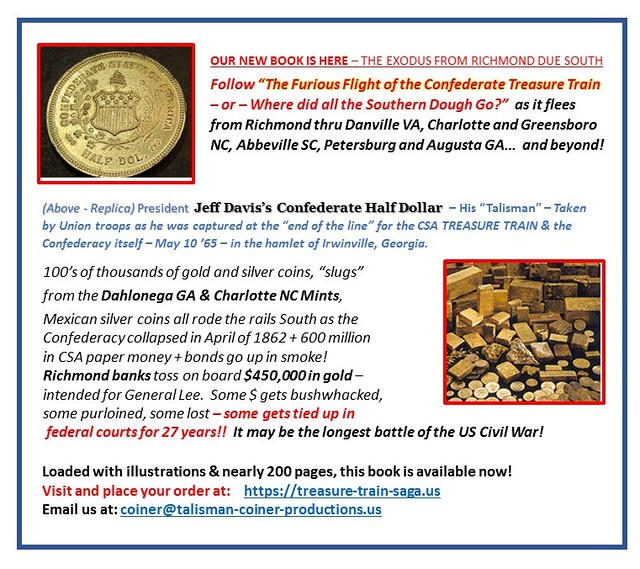
THE TRAGIC LIFE OF MODEL AUDREY MUNSON
In 2016 we discussed a new book on the life of model and actress Audrey Munson, who modelled for coin artist Adolph Weinman. A new article in the Washington Post quotes the book author James Bones and numismatist Dave Bowers. Here's an excerpt. -Editor
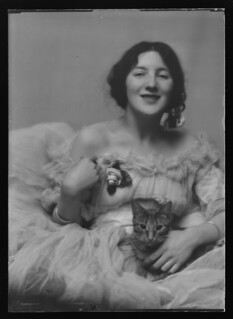 Q. David Bowers has two passions: coins — he’s one of the country’s leading numismatists — and the early history of Hollywood. In Audrey Munson, those two passions intersected.
Q. David Bowers has two passions: coins — he’s one of the country’s leading numismatists — and the early history of Hollywood. In Audrey Munson, those two passions intersected.
Many coin collectors believe the artists’ model was the inspiration for the figure on the Mercury head dime, designed in 1916 by Adolph Weinman. And Munson starred in a handful of famed silent films.
The first was the now-lost 1915 movie, “Inspiration.” In the 1980s, Bowers was researching the history of the studio that made it, Thanhouser. He was determined to trace the lives of as many studio figures as possible. Miraculously, he found Audrey Munson.
“She was still alive,” Bowers told me.
Munson was in a mental hospital in Ogdensburg, N.Y., across the St. Lawrence River from Canada. She had been committed to the asylum in 1931. Munson lived there until her death in 1996 at age 104.
Said Bowers, who lives in New Hampshire: “She lived what I call a tragic life, a life that could have been happier.”
I was hoping for a happy ending for this groundbreaking woman, who inspired artists as a model then appeared unashamedly nude in movies, including 1916’s “Purity,” written by Washington author Clifford Howard.
Munson was cheated by movie producers. Then in 1919, the landlord of the Long Island, N.Y., boardinghouse she and her mother, Kittie, lived in murdered his wife, allegedly because of his obsession with Audrey. Scandal ensued.
None of this helped Munson’s fragile mental state.
Said Bone: “My take is she was a vulnerable girl from a very poor background, boosted into the spotlight — like so many Hollywood stars — who collapsed under the spotlight. She’s the first Hollywood burnout, really.”
Munson was the model for another Weinman work, a stunning sculpture called “Descending Night.” A bronze copy is in the collection of the Smithsonian American Art Museum.
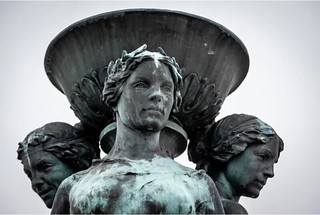 And just inside the gates of the McMillan Reservoir, a block off North Capitol Street, you will find Audrey Munson in triplicate. Herbert Adams’s monumental fountain honoring Sen. James McMillan depicts her as the Three Graces.
And just inside the gates of the McMillan Reservoir, a block off North Capitol Street, you will find Audrey Munson in triplicate. Herbert Adams’s monumental fountain honoring Sen. James McMillan depicts her as the Three Graces.
The bronze fountain has seen better days. It’s not functional and one figure is missing some fingertips. But as I looked at it the other day, I tried to imagine the beautiful, troubled woman who was its inspiration.
As Roger Burdette noted in the earlier article,
"One can legitimately state that Adurey Munson modeled for Adolph Weinman at sometime or another. This is noted in his archival papers... Being an artist's model does not mean the model's likeness is on a completed work of art. Most art images are composites and only individual portraits - usually made on commission by the subject - are likenesses. Munson was among the bits and pieces from multiple models and ideas that resulted in the final artistic product."
I made a correction suggested by Dave Bowers - Weinman designed the dime in 1916. -Editor
To read the complete article, see:
For model and actress Audrey Munson, a long and tragic final chapter
(https://www.washingtonpost.com/local/audrey-munson/2021/01/13/bf5c84bc-559c-11eb-a08b-f1381ef3d207_story.html)
To read the earlier E-Sylum article, see:
NEW BOOK: THE CURSE OF BEAUTY
(https://www.coinbooks.org/esylum_v19n15a04.html)
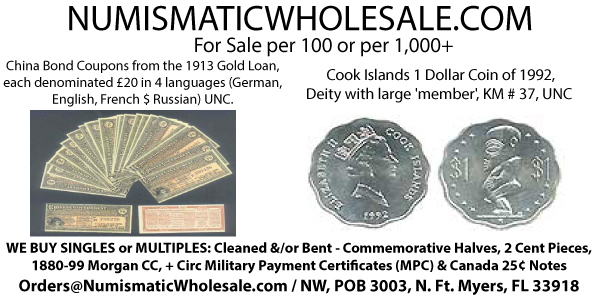
VOCABULARY TERM: STRIKING
Here's another entry from Dick Johnson's Encyclopedia of Coin and Medal Terminology. -Editor
Striking. Forming relief objects by an impression with a pair of dies and the force of a press. Presses utilize two dies, one obverse, one reverse, to impart the design on both sides at once. The first press, used at the beginning of the 16th century, were screw presses. They were able to strike small thin coins and were powered by man, or more likely two men. Each pressed against a long bar that transferred the motion – by a transversal screw – a downward thrust of a housing containing one of the dies (usually the reverse, where the obverse die is fixed in the pile position below). Pressing creates the raised relief on both sides of the struck piece at one time.
The screw press was used for nearly 400 years. Its improvement came slowly at first, but as the presses were built stronger and with attachments to feed blanks and eject struck pieces, the striking improved. As power changed from man to horse to steam power, larger diameter pieces could be struck with greater depth of impression.
With the invention of the togle-joint press in 1816 greater control over the impression became possible. Each development of this press had an effect on its capability to strike a piece of greater diameter, thicker planchet, better surface control, sharper detail and edge treatments with a sharper rim/edge juncture.
Pre-preparation of the blank aided striking greatly – by upsetting – leading to automated coining, and, ultimately, high speed coining. This was further enhanced when electric motors were applied to coining presses.
Striking is one of five major methods of reproducing numismatic items, the others are casting, repoussé, niello, forged. While each of these has its own place, striking alone is the only method of manufacture suitable for coining – striking in a coin press – for high speed manufacture of highly detailed small disklike objects often of valuable metal.
History of striking. Coins made before the use of a press are known as hammered, formed with a sledge blow to a punch with a blank placed between it and the die in the pile position below, each imparting a design image. The coiners were moneyers who produced the hammered coins manually. These workers were so well entrenched that when the screw press was introduced (in 1551 in France, and 1561 in England) that the moneyers were able to thwart the continued use of the screw press for nearly a century.
Hammered coins, therefore, were not phased out until 1641 in France and 1662 in Great Britain. Thus the screw press, which was developed for coining in 1506 in Italy, was not fully in use elsewhere until more than 150 years later! Striking dates from this irresolute period of coining history.
Matthew Boulton did more to improve striking than any other individual in coining history. He not only applied the power from his steam engines, but also developed better blank preparation, upsetting, but also used the finest steel for dies he could obtain (from Benjamin Huntsman, who had developed crucible steel in 1756).
Diedrick Uhlhorn invented the togrel-joint coining press in Germany in 1816. This was improved upon by Eugene Thonnelier in France in 1836. Each of these presses struck coins with better striking control, higher quality and better relief surfaces than before. Their power derived from steam or water, transferred to the presses by belts.
The hydraulic press was invented about this same time, but it was too slow for coining, The togel-joint press gave a sharp blow for the impression in contrast to the squeeze of the hydraulic press.
For the last half of the 19th century the screw press and the togel-joint press were is use simultaneously. It was only when commercial electricity and electric motors became available and these were applied to run presses that it was learned that it was easier to electrify togel-joint presses than screw presses, that the later was phased out of coin production.
Thus the development of striking paralleled the development of presses and how they were powered. Striking improved by sharper images, in larger diameter coins, with dies that lasted for longer press runs. See presses and pressroom practice.
References:
C24 {1948} Mason.
NC6 {1960} Peck, p 141, note 1.

THOMAS KING BIRCH, JR. (1812-1883)
Here's another entry from the online draft of John Lupia's book of numismatic biographies. Thanks! This is an excerpt with the full article and bibliography available online. This week's subject is Thomas King Birch, Jr. -Editor
Thomas King Birch, Jr. (1812-1883), was born on May 1, 1812 at Philadelphia, Pennsylvania, the son of the famous English born artist, Thomas Birch (1779-1851). His grandfather was William Russell Birch (1755-1834), of Warwickshire, England, who published, Birch's Views of Philadelphia (1800), and who is attributed by some as the engraver of the so-called Birch Cent of 1792. William first came to Philadelphia in 1772. Currently, no documentary evidence supports the attribution of his engraving the Birch Cent, though some American numismatists still argue in its favor. William Russell Birch was born the son of Thomas Birch (1715-1798?) and Anne Russell (1713-1804). The engraver of the Birch Cent might be William's father, not his son.
On October 27, 1831, he married Elizabeth Steinmetz (1810-1873), and they had fourteen children.
In 1845 he opened an auction house at 173 Chestnut Street, Philadelphia calling the firm Thomas Birch, Jr.
In 1864, taking his son Edwin King Thomas (1839-1898), as a partner he renamed the firm Thomas Birch & Son. The firm remained with this name until 1878.
From 1887-1890 the firm of Thomas Birch's Sons had an arrangement with Stanislaus Vincent Henkels as the book cataloguer.
He died on February 21, 1883 at Philadelphia, Pennsylvania.
Perhaps the most significant auction of the firm took place for the Estate, Lawrence Lewis (Washington's Executor) ; Estate, Lorenzo Lewis (Lawrence Lewis' Executor) ; by Order of H. L. D. Lewis (administrator to Estate Mrs. Lorenzo Lewis) ; Thomas Birch's Sons, Auctioneers Stanislaus Vincent Henkels
To read the complete article, see:
BIRCH, THOMAS KING
(http://www.numismaticmall.com/numismaticmall-com/birch-thomas-king)
HARVEY STACK'S NUMISMATIC FAMILY, PART 87
The latest article in Harvey Stack's blog series wraps up his discussion of the firm's 1982 sales. Thanks. -Editor
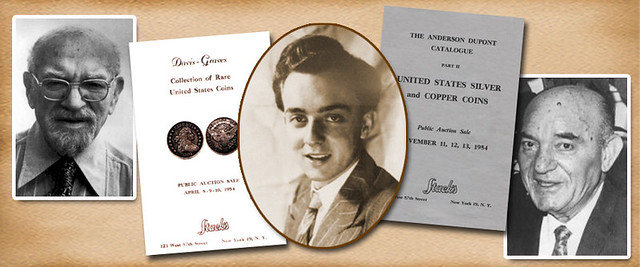
Our stellar series of 1982 auction sales continued in March, when Princeton University consigned a substantial collection of world gold and silver coins to raise funds to expand a variety of library services. In addition, other consignments of United States coins brought the lot count for this event to 1,484 lots.
In May Stack's conducted the annual Metropolitan New York Numismatic Convention Auction, as we had for many years. It featured a comprehensive offering of over 1,550 lots of Ancient and World coins and United States coins. The sale was designed to attract collectors of many different series to help make the convention's attendance a great success. The variety of types as well as a wide range of grades were included in the sale, enhancing its wide-ranging appeal. Our June sale of over 1,300 lots also offered United States and World coins, and once again featured items that would appeal to a beginner as well as superb rarities for specialized collectors.
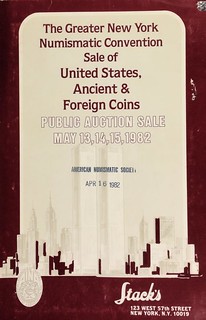
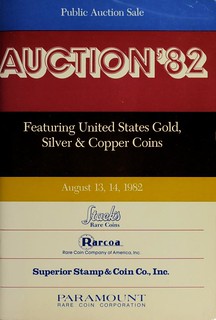
August 1982 brought another of our successful "Apostrophe Auctions," held with Rarcoa, Paramount and Superior. Once again each firm was responsible for providing 500 rare and choice coins, and by now this event had a reputation that brought the foremost collectors to the sale, as well as attracting huge amounts of bid sheets. In September Stack's was honored to present the renowned collection of 19th and 20th century world gold coins formed Mortimer Hammel, a dedicated numismatist and friend of our entire family. In the 1930s, Mr. Hammel had developed a technique of fusing copper and silver, a process that was much needed in industry. This enabled him to retire and, as he lived in walking distance of Stack's he had the time to visit often. He was not only a collector but an expert and he taught all of us about rarity and value in the foreign series. He had a great love for the gold coins of the 1800s and early 1900s, but had a particular interest in Spanish Colonial issues. He was of great assistance as we built the J.K. Lilly collection, guiding us as we put together some 500 different Spanish-American gold coins.
His collection consisted of almost 1,100 different type coins of the two centuries, gathered with condition and rarity as the first requirement. This was another landmark sale for Stack's and our auction room was filled with collectors from both the United States and many other countries all hoping to capture some of the great rarities in the Hammel Collection.
 In October, we offered 1,654 lots of United States and Foreign Gold, Silver and Copper Coins, along with Paper Money, highlighting the Estate of August Bohnhorst and the Carl S. Carlson collections. It was a great comprehensive offering for buyers in all fields and areas of collecting and was excitedly received and bid on. In December we brought to public auction Part III of the Robison Collection, featured alongside other compatible consignments. As with the earlier offerings from the Robison Collection, the funds raised were donated to Cornell University and Rensellaer Polytech to support the Robison family's commitment to higher education and the athletic activities at those institutions. "Roby" expressed his feelings on this subject, asserting that healthy sporting activity was a great support to education, and that he wanted to enhance it as best he could.
In October, we offered 1,654 lots of United States and Foreign Gold, Silver and Copper Coins, along with Paper Money, highlighting the Estate of August Bohnhorst and the Carl S. Carlson collections. It was a great comprehensive offering for buyers in all fields and areas of collecting and was excitedly received and bid on. In December we brought to public auction Part III of the Robison Collection, featured alongside other compatible consignments. As with the earlier offerings from the Robison Collection, the funds raised were donated to Cornell University and Rensellaer Polytech to support the Robison family's commitment to higher education and the athletic activities at those institutions. "Roby" expressed his feelings on this subject, asserting that healthy sporting activity was a great support to education, and that he wanted to enhance it as best he could.
At Stack's we continued to feel lucky to have attracted so many dedicated collectors to both our shop and our auctions. Despite fluctuations in the market, we had a very successful year in 1982 and continued to enjoy serving our clients in any way we could. The markets were getting stronger as confidence grew in the hobby. In addition, we were about to see some outstanding collections come through our doors for public auction. These and other factors came together to make 1983 a super year for all of us at Stack's.
To read the complete article, see:
Harvey Stack Remembers: Growing up in a Numismatic Family, Part 87
(https://www.stacksbowers.com/News/Pages/Blogs.aspx?ArticleID=harvey-stack-remembers-part-87)
To read the 1982 Stack's sales on the Newman Numismatic Portal, see:
Stacks-Bowers Galleries
(https://nnp.wustl.edu/library/auctioncompanydetail/3?Year=1982&displayAmt=50)
To read the earlier E-Sylum article, see:
HARVEY STACK'S NUMISMATIC FAMILY, PART 86
(https://www.coinbooks.org/v24/esylum_v24n01a17.html)
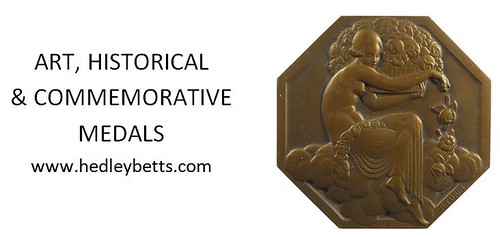
JOHN THOMPSON AND CHASE MANHATTAN BANK
Economic historian John Steele Gordon writes a column for the ABA Banking Journal. This month's installment has a numismatic literature connection - the publisher of Thompson’s Bank-Note Reporter also founded one of the largest banks in the country. -Editor
 In the last column I wrote about the curious origin of the Bank of the Manhattan Company. Another major antecedent company of what is today JPMorgan Chase was Chase National Bank, founded by John Thompson in 1877.
Thompson had been born in Peru, Massachusetts, in 1802. After a stint as a lottery dealer in Albany, New York, he moved to New York City in 1832 and became a dealer in bank notes. At that time state-chartered banks issued bank notes and there were thousands of different issues—some sound, some fraudulent.
In the last column I wrote about the curious origin of the Bank of the Manhattan Company. Another major antecedent company of what is today JPMorgan Chase was Chase National Bank, founded by John Thompson in 1877.
Thompson had been born in Peru, Massachusetts, in 1802. After a stint as a lottery dealer in Albany, New York, he moved to New York City in 1832 and became a dealer in bank notes. At that time state-chartered banks issued bank notes and there were thousands of different issues—some sound, some fraudulent.
In 1836, Thompson founded Thompson’s Bank-Note Reporter, a weekly that sought to sort out the good notes from the bad ones. (Thompson’s Bank-Note Reporter is the progenitor of today’s American Banker, which due to its name is often assumed to be published by the American Bankers Association, although it remains an unaffiliated publication. In fact, it took its name a decade after the founding of ABA, which leaves any blame for the confusion at the feet of American Banker’s long-ago owners.)
Thompson was forced into bankruptcy in the panic of 1857 but was soon back on his feet, and in 1863 he co-founded the First National Bank of the City of New York, the ancestor of today’s Citigroup. He soon brought on board the 23-year-old George F. Baker who would come to dominate that bank for many years.
In 1877, Thompson and his sons withdrew from First National and founded Chase National Bank, named in honor of the late Treasury Secretary and Chief Justice Salmon P. Chase.
In 1955 Chase National Bank merged with the Bank of the Manhattan Company. Although Chase was a far larger institution and had originally intended to acquire the smaller bank, it turned out that Aaron Burr’s 1799 charter contained a poison pill. Besides allowing a company ostensibly created to provide Manhattan with clean water to open a bank, the charter also forbade the sale of the company unless the stockholders unanimously agreed to it.
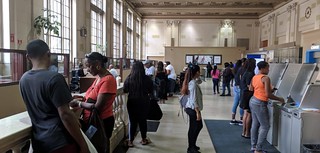 Therefore, the merger was structured as a purchase of Chase by the Manhattan Company, to form Chase Manhattan Bank. In 1961, the well-known graphic design firm of Chermayeff and Geismer designed the octagon logo that has symbolized Chase ever since.
Therefore, the merger was structured as a purchase of Chase by the Manhattan Company, to form Chase Manhattan Bank. In 1961, the well-known graphic design firm of Chermayeff and Geismer designed the octagon logo that has symbolized Chase ever since.
With the merger, Chase Manhattan became one of the largest banks in the country—a distinction its successor firms have continued.
To read the complete article, see:
Chasing Down History
(https://bankingjournal.aba.com/2021/01/chasing-down-history/)
To read issues of Thompson’s Bank-Note Reporter on the Newman Numismatic Portal, see:
Thompson's Bank Note Reporter
(https://nnp.wustl.edu/library/publisherdetail/510102)

CHICAGO HALL OF FAME INDUCTS ALDEN SCOTT BOYER
The Chicago Coin Club has announced the thirteenth inductee into its Hall of Fame. -Editor
Inducts Alden Scott Boyer Into its Hall of Fame
The Chicago Coin Club announces that the thirteenth person to be inducted into its Hall of Fame is Alden Scott Boyer. His Hall of Fame citation has been published on the club’s Hall of Fame web page, www.chicagocoinclub.org/projects/hof .
Here is the text of the Alden Scott Boyer entry. -Editor
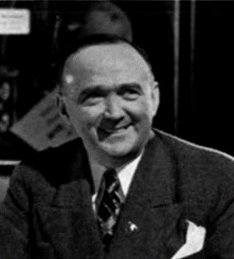 In 1919 ANA Branch No. 1 was revived as the Chicago Coin Club. The Vice President of Branch No. 1, Alden Scott Boyer, was re-elected to that position in the new club. As a charter member of the new club he became member number 7 and that same year was elected president of the Chicago Coin Club. He held office from 1919 to 1927, helping establish firm roots for the revived club.
In 1919 ANA Branch No. 1 was revived as the Chicago Coin Club. The Vice President of Branch No. 1, Alden Scott Boyer, was re-elected to that position in the new club. As a charter member of the new club he became member number 7 and that same year was elected president of the Chicago Coin Club. He held office from 1919 to 1927, helping establish firm roots for the revived club.
Born in Cresco, Iowa in 1887, Mr. Boyer graduated from the Northwestern School of Pharmacy in 1908. In 1912 he incorporated the Boyer Chemical Laboratory Company, specializing in chemical products, perfumes, and cosmetics. In 1923 he set up a French cosmetic division, The Society Perfumer, in Paris. During the 1920s the Club frequently met at the Boyer Building at 2700 South Wabash Avenue in Chicago.
In addition to his service with the Chicago Coin Club, Alden Boyer was life member number 14 of the ANA. He served as general secretary of the ANA in 1921 to 1922, vice president 1925 to 1930, and as the 18th ANA President from August 26, 1932, to August 31, 1933.
Mr. Boyer’s interest in numismatics started with the study and collecting of revolutionary period currency. This interest evolved to include encased postage, fractional and large specie currencies, and finally concentrated on classical Greek ancients. He had two major collections. First, was his collection of colonial money that went to the Ludger Gravel Museum in Montreal. The second was a collection of paper money, sold by B. Max Mehl in 1928. A portion of Mr. Boyer’s collection was stolen from his office at Boyer Chemical Laboratory Co. on North Clark Street on October 18, 1920. Thieves rifled through one of his three safes there, taking bank notes from his collection. After Mr. Boyer’s death, his library was sold at auction by Hanzel Galleries in Chicago February 23, 1954.
Mr. Boyer was a prolific collector beyond coins. Starting with baby ribbons, advertising and picture postcards, and tobacco tags in childhood, he also collected perfume bottles, automatic coin devices, automatic pianos, and stamps. Mr. Boyer purchased a bank building in Chicago to house the Boyer Museum of American Curiosities. In 1938 he also formed the Chicago Coin Device Museum, housed in the Boyer Building, which featured coin operated entertainment devices. Around the same time, he commenced assembling an important collection of historical photographs and books on photography.
For 41 years Mr. Boyer was accompanied in these collecting activities by his wife Marie, whose interests included perfumes, daguerreotypes and laces. This collecting team was sadly broken by her death on May 1, 1950. Mr. Boyer later remarried Elizabeth Marie Johnson.
At the Chicago Coin Club’s 1951 banquet, Mr. Boyer entertained the members with his speech on what he collected and how, as his many hobbies grew, a warehouse was used to store these items.
Alden Boyer had no children and donated his collection of photographs to the George Eastman House in Rochester, New York in 1950, where it can still be viewed. He was president of the Boyer Museum for the Preservation of American Antiquities from 1935 until his death on June 16, 1953. The September 1953 edition of The Numismatist paid tribute to him by noting, “Alden Scott Boyer can no longer take an active part in future collecting activities, but what he accomplished in his active years will be felt and appreciated by those who may strive to fill the tremendous void that his passing has made obvious.”
Does the Ludger Gravel Museum still exist? Would anyone know what became of Boyer's colonial money collection? -Editor
To read the complete article, see:
Hall of Fame
– Chicago Coin Club –
Member 13
Alden Scott Boyer
(http://www.chicagocoinclub.org/projects/hof/m13.html)
To read an earlier E-Sylum article, see:
CHICAGO COIN CLUB INITIATES HALL OF FAME
(https://www.coinbooks.org/v21/esylum_v21n48a12.html)
CHICAGO HALL OF FAME INDUCTS CARL WOLF
The Chicago Coin Club also announced the fourteenth inductee into its Hall of Fame (and first living member) Carl Wolf. Congratulations! -Editor
Inducts Carl Wolf Into its Hall of Fame
The Chicago Coin Club announces that the fourteenth person to be inducted into its Hall of Fame is Carl Wolf. His Hall of Fame citation has been published on the club’s Hall of Fame web page, www.chicagocoinclub.org/projects/hof .
Here is the text of the Carl Wolf entry. -Editor
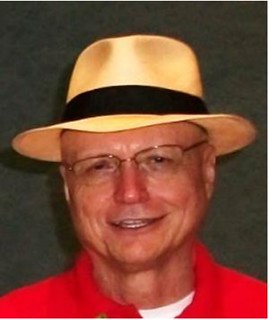 Mr. Carl Wolf, life member #904 of the Chicago Coin Club, is inducted into our Hall of Fame as the first living member. We are grateful for his service. Mr. Wolf is renowned for his enthusiastic and tireless support of the Chicago Coin Club (CCC), encouragement of young numismatists, and his stylish and signature chapeau. Mr. Wolf (born August 19, 1947) began his life on a dairy farm in Fulda, Minnesota. He later matriculated through the University of Minnesota with a degree in mathematics. His career began at F. W. Woolworth Co. in Minneapolis and later with Control Data Corporation. He was offered a promotion and transferred to Chicago in 1974. There, he met Jennie Sochon. They worked for different companies but on the same floor in 430 N. Michigan Ave. It was his first day at the Chicago office and her company’s first day at their new location. They were married in Chicago in 1977. A merger and sale of Mr. Wolf’s department was the inspiration to launch Carl Wolf & Co. in 1981, which continues to present. His business branched out from computer forms to marketing and awards, a good fit for his creativity.
Mr. Carl Wolf, life member #904 of the Chicago Coin Club, is inducted into our Hall of Fame as the first living member. We are grateful for his service. Mr. Wolf is renowned for his enthusiastic and tireless support of the Chicago Coin Club (CCC), encouragement of young numismatists, and his stylish and signature chapeau. Mr. Wolf (born August 19, 1947) began his life on a dairy farm in Fulda, Minnesota. He later matriculated through the University of Minnesota with a degree in mathematics. His career began at F. W. Woolworth Co. in Minneapolis and later with Control Data Corporation. He was offered a promotion and transferred to Chicago in 1974. There, he met Jennie Sochon. They worked for different companies but on the same floor in 430 N. Michigan Ave. It was his first day at the Chicago office and her company’s first day at their new location. They were married in Chicago in 1977. A merger and sale of Mr. Wolf’s department was the inspiration to launch Carl Wolf & Co. in 1981, which continues to present. His business branched out from computer forms to marketing and awards, a good fit for his creativity.
Mr. Wolf’s interest in Numismatics began when a friend, Vic Miller, introduced him to Whitman folders. This is the spark that ignited his lifelong interest in history and love of research. Joining the CCC in 1979, Mr. Wolf immediately committed his talents to the club by serving as Secretary & Treasurer from 1979 through 1984. For his service he received the CCC Medal of Merit in 1981. The year 1985 was a milestone for the club. In September of that year the club celebrated its 800th consecutive meeting, and for that event Mr. Wolf co-authored The History of the Chicago Coin Club with his wife Jennie Sochon. The work was published in Perspectives in Numismatics, and remains as the seminal work on the history of the CCC. Following his tenure as Secretary and Treasurer, he served as Club Archivist from 1985 to 1990.
Concurrent with his service to the CCC, Mr. Wolf is active in the American Numismatic Association (ANA). He conducted the Numismatic Theatre at the 1984 ANA convention in Detroit Michigan, presenting 22 programs. This featured some of the best known numismatic personalities, including Director of the Bureau of Engraving and Printing, Robert J. Leuver, and the Director of the Mint, Donna Pope. The ANA Centennial notes that Mr. Wolf furnished a five-star non-stop educational program given every hour. This service to the ANA was repeated again in 1986, and by 1987 ANA Director of Education, Ken Bressett, noted that, “The Numismatic Theater, presented at each ANA anniversary convention, attracts an ever-increasing audience under the capable guidance of ANA member Carl Wolf.” In that same year, ANA president Stephen Taylor commended Mr. Wolf on the quality of his service. He received the Krause Numismatic Ambassador Award in 1987. His guide for numismatic speakers – available on the Newman Numismatic Portal – remains a viable reference today.
Carl Wolf has continued to support the ANA as a convention volunteer. In recognition of his effort, the ANA has awarded Mr. Wolf the Glenn Smedley award in 1989, Presidential Award in 2013, and Medal of Merit in 2015. His service to the CCC has never wavered, serving as 2nd VP, 1st VP from 1997 to 1999, and President from 1999 to 2002. As President, he served on the committee presiding over the club’s 1000th meeting celebration held April 6, 2002 in conjunction with the Chicago International Coin Fair (CICF) held in Rosemont. Mr. Wolf continued service on the Board of Directors from 2003 to 2012. In 2007 he was awarded the Chicago Coin Club Lifetime Achievement Award during a roast in his honor. (Membership is hopeful we are forgiven.) Mr. Wolf has continued to serve the CCC as club Secretary from 2005 to present.
Mr. Wolf is the recipient of the club’s Cabeen Award, receiving the Gold in 1982, 1992, 2000, and 2009, with silver and bronze awards in 1980, 1981, 1987, 1999, 2001, 2002, 2003, and 2010. His beautifully framed primitive money has been showcased at numerous meetings. He is currently serving as President of the International Primitive Money Society.
Thank you, Mr. Wolf, for your service to numismatics and our club.
To read the complete article, see:
Hall of Fame
– Chicago Coin Club –
Member 14
Carl Wolf
(http://www.chicagocoinclub.org/projects/hof/m14.html)
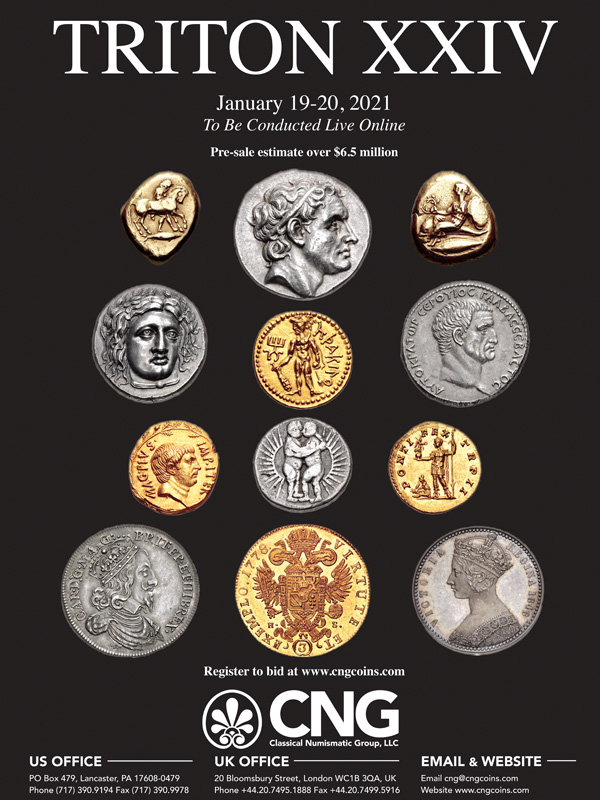
NYINC AWARDS MEDAL OF MERIT TO WETTERSTROM
The New York International Numismatic Convention (NYINC) has created the Richard Margolis Medal of Merit; the inaugural honoree is Kerry Wetterstrom. Congratulations! Here's the press release. -Editor
Honors Kerry Wetterstrom
Named as Recipient of Inaugural Richard Margolis Medal of Merit
 Kevin Foley, Bourse Chairman for the New York International Numismatic
Convention, has announced that the NYINC board has named Kerry Wetterstrom
to receive the inaugural Richard Margolis Medal of Merit.
Kevin Foley, Bourse Chairman for the New York International Numismatic
Convention, has announced that the NYINC board has named Kerry Wetterstrom
to receive the inaugural Richard Margolis Medal of Merit.
Foley said, “Richard Margolis was the guiding force in the original founding of the NYINC and hands on managed and administered our event for many years. In addition, he was a significant dealer and researcher in the field of French numismatics. Naming our medal of merit in his honor will remind future generations of his significant contributions to numismatics.”
Kerry Wetterstrom served as the NYINC’s education director from 2000 through 2020. In that time he arranged for and hosted roughly 150 of the club meetings and educational programs that have become a vital part of the NYINC. Kerry’s numismatic interests began in 1974 when he purchased his first ancient coin from dealer Tom McKenna. He is currently employed as a Senior Numismatist by Lancaster, Pennsylvania based Classical Numismatic Group.
In 1999 he became the editor and publisher of The Celator magazine, a journal focused on the ancient numismatics specialty area, prior to rejoining the staff of CNG. He has also lectured widely on different aspects of ancient numismatics, appearing before such groups as the San Francisco Ancient Coin Club, the Twin Cities Ancient Coin Club, Historia Nummorum in Boston, the Ancient Numismatic Society of Washington, D.C., the Chicago Coin Club and others. In addition, he has been an instructor at the American Numismatic Association’s widely acclaimed Summer Seminar since 1994. He is also a fellow of the London based Royal Numismatic Society and the American Numismatic Society. Wetterstrom’s area of specialty focus is coins of Roman Egypt. He wrote the chapter exploring that specialty in Ancient Coin Collecting – Vol. 4.
Foley concluded by saying, “Kerry Wetterstrom has spent a lifetime giving back to the field of numismatics as a dealer, publisher, editor, author, lecturer and researcher. Naming him to receive the first ever Richard Margolis Medal of Merit is not only well deserved, but will set the future standards of accomplishment in the field that will enhance this award and memorialize the significant contributions made to the NYINC and the numismatic community by Richard Margolis.”
To read earlier E-Sylum articles, see:
COINSWEEKLY BIOGRAPHY: KERRY WETTERSTROM
(https://www.coinbooks.org/v20/esylum_v20n22a23.html)
ANA HONORS DISTINGUISHED NUMISMATISTS
(https://www.coinbooks.org/v22/esylum_v22n29a19.html)
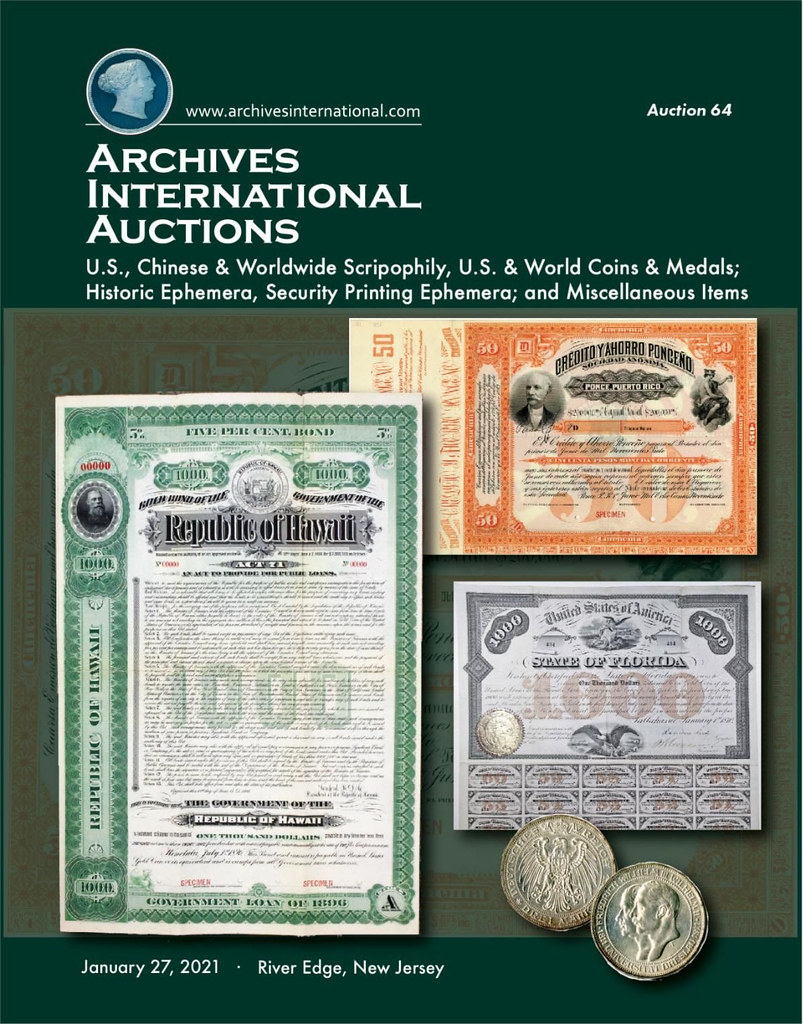
2022 NEW YORK INTERNATIONAL PLANNED
Although this year's New York International has been cancelled, plans are underway for the 2022 event. Here's the press release. -Editor
50th Annual Foreign and Ancient Specialty Event
 Kevin Foley, long time bourse chairman for the New York International
Numismatic Convention, has announced the preliminary schedule for the
convention’s 50th annual edition.
Kevin Foley, long time bourse chairman for the New York International
Numismatic Convention, has announced the preliminary schedule for the
convention’s 50th annual edition.
The event will once again be held at the Grand Hyatt New York, located at 109 East 42nd Street between Park and Lexington Avenues. The Grand Hyatt enjoys a direct indoor connection with Grand Central Station, terminus of the Metro North commuter system, as well as having stops for multiple subway lines.
Foley said, “We’ll once again have ten full days of numismatic specialty activities at the NYINC. Auction lot viewing for our eight days of foreign and ancient specialty sales featuring nine different companies will get underway on Friday, January 7. Auctions sessions will run from Sunday, January 9 through Sunday, January 16. We anticipate having 16 separate auction sessions throughout the week sponsored by our multiple official auction companies.
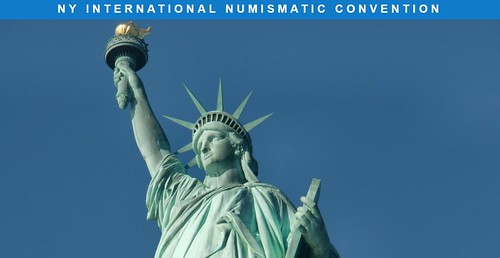
The 125 dealer foreign and ancient specialty area bourse starts with the Early Bird/Professional Preview day Thursday, January 13 from 12noon until 7PM. There is a $125 registration fee. Regular public hours will be Friday and Saturday, January 14-15 from 10AM-7PM and Sunday, January 16 from 10AM-3PM, with a $20 registration fee for the Friday through Sunday regular public hours. A $5 discount coupon is available on the NYINC website.
Educational programs and club meetings will be held all day on Saturday, January 15.
Information about discounted room rates at the Grand Hyatt under the NYINC room block will be available on the NYINC website, www.nyinc.info. Site visitors will also find the complete Schedule of Events as well as a listing of confirmed booth holders. In the months approaching the convention dates additional programs and booth holders will be posted.
Numismatic Guaranty Corporation is an official grading company of the NYINC and will have a booth at the convention to accept numismatic items for certification and grading.
Bourse applications are available from Foley by calling him at (414) 807-0116 or via e-mail at kevinsfoley.kf@gmail.com.
To read the earlier E-Sylum article, see:
2021 NEW YORK INTERNATIONAL CANCELLED
(https://www.coinbooks.org/v23/esylum_v23n39a15.html)
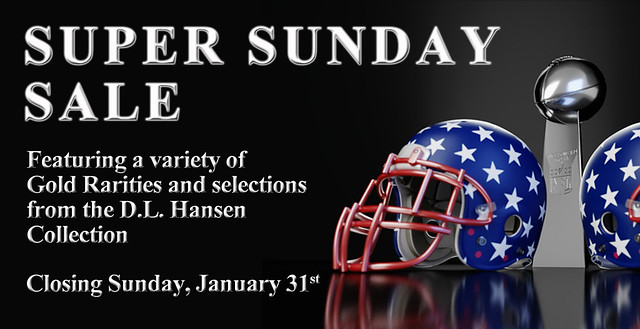
SYLVESTER ANNAMESE MEDALS AND ORDERS
The Stephen Album Rare Coins Auction 39 features an amazing collection of Annamese Medals and Orders. Here's the press release. -Editor
The John Sylvester Jr. Collection of Annamese Medals and Orders will be featured in the upcoming Stephen Album Rare Coins Auction 39 (January 21-25, 2021). It is highlighted by several pieces never-before seen at auction. A quick overview of the Collection will show that it is unrivaled in its specialty and promises to be the premier auction to date of Annamese Orders and Medals. The catalog should be a reference for this material for years to come.
One of the premier experts and authors on Southeast Asian phaleristics, John Sylvester Jr. (1930), inherited a love for Asian antiques from his father, a decorated vice admiral who was stationed in China in the late 1930’s. After seeing combat near the end of the Korean War, he entered the Foreign Service in 1955 and began a ten-year tenure in Japan, where he met his future wife, Mayumi. A seasoned diplomat, he was assigned in 1968 to South Vietnam and tasked with advising various provinces along the Cambodian border. It was in that volatile milieu that John developed an interest in medals, which eventually became an addiction. After retirement, he became the first director of the NC Japan Center in 1981 and amassed in a single room in his home in Raleigh a panoply of military paraphernalia, including hats, aiguillettes, flags, bayonets, flare guns, and one of the finest collections of Indochinese medals and orders in the world.
Some highlights from the collection follow:
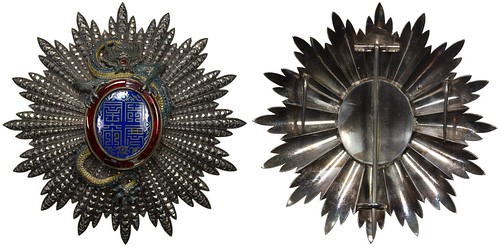
Lot 1481
LOT 1481. NGUYEN DYNASTY (ANNAM): Dong Khanh, 1885-1889, Order of the Dragon of Annam, Barac-92, Werlich-407, Sylvester-3/1/b, 97mm, Grand Officer Breast Star, silver star with faceted surface & 16 multi-tipped rays; at center, a blue enameled oval emblazoned with the imperial seal & encircled by a red band; above, a roaring dragon in teal facing, its claws clutching the oval and its body coiled below // pinback with two retaining hooks, tiny hallmark on pin catch, small cracks & chips in the enamel, EF, R. Estimated at $800 - 1,000.
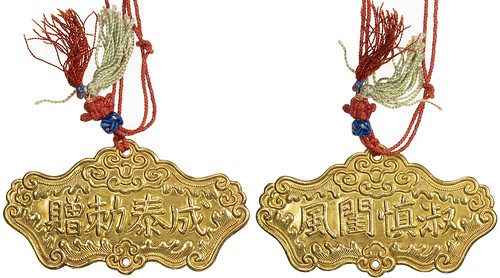
Lot 1488
LOT 1488. NGUYEN DYNASTY (ANNAM): Thanh Thai, 1889-1907, AV kim khánh medal (12.57g), Barac-77, cf. Sylvester-1/C/3/B, 66 x 36mm, Order of Kim Khánh Middle Class, made with two pieces of repoussé gold, thanh thai sac tu // thuc than khue mon (“Bestowed by Khanh Thai // Pure, prudent, [observant of] chastity”), framed by floral decoration with curlicues at the top, bottom & corners, attached at top with red cord, a gorgeous local-style example, choice AU, RR. Estimated at $1,500 - 2,000.
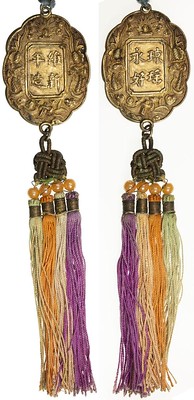

Lots 1494 and 1510
LOT 1494. NGUYEN DYNASTY (ANNAM): Duy Tan, 1907-1916, AV kim bôi medal (23.88g), Barac-66, S&H p. 70, 2.2.2, 44 x 55mm, Order of Kim Bôi 2nd Class, made with two pieces of repoussé gold, quynh dao vinh hay // duy tan nien tao (“Fine jade is eternally beautiful // Made during the reign of Duy Tan”) within center rectangle, flanked by two phoenixes & clouds, radiant sphere above, attached at top with blue woven cord, and at bottom with elaborate knot & four braids of silk tassels, each with a pearl, AU, RR. Estimated at $2,500 - 3,500.
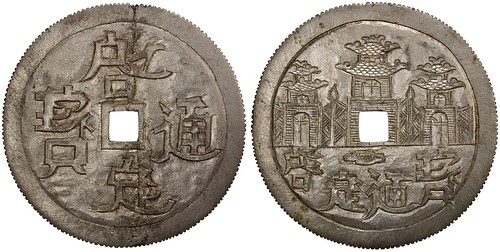
Lot 1495
LOT 1495. NGUYEN DYNASTY (ANNAM): Khai Dinh, 1916-1925, AR medal (24.00g), Joyaux—, 50mm, hand-engraved khai dinh thong bao around square hole // city wall with three towers, the same characters below, vertical edge milling, AU. Estimated at $400 – 600.
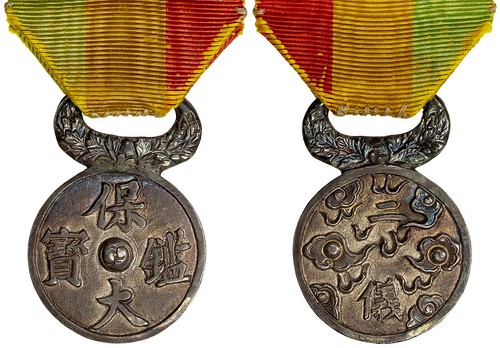
Lot 1504
LOT 1504. NGUYEN DYNASTY (ANNAM): Bao Dai, 1926-1945, AR 2 tiên medal (8.31g), Barac—, Joyaux-724, 27mm, made from two pieces of metal, bao dai bao giam around thai cuc // nhi nghi (“yin & yang”) flanked by two spheres & auspicious clouds, green-yellow-red ribbon attached on Western-style mount engraved with wreath, gorgeous smoky toning with notes of iridescence, EF, RR. Estimated at $500 – 700.
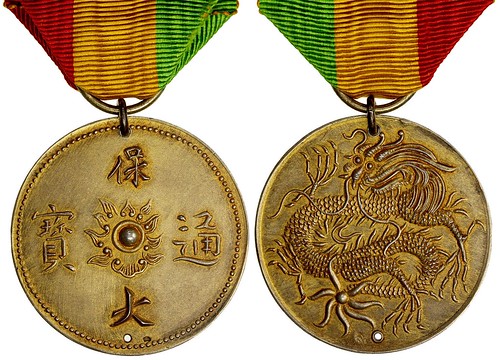
Lot 1508
LOT 1508. NGUYEN DYNASTY (ANNAM): Bao Dai, 1926-1945, gilt 4 tiên (14.83g), Barac-25, cf. Joyaux-624, 36mm, bao dai thong bao around small pearl with 9 flames, 6-stroke bei, 2-dot thong // phi long (“flying dragon”) left, pierced at top & bottom and attached with red-yellow-green ribbon, choice AU, RR. Estimated at $600 – 800.
LOT 1510. NGUYEN DYNASTY (ANNAM): Bao Dai, 1926-1945, medallic AR 5 tien (23.18g), cf. KM-XM5, Joyaux-713, 33mm, phi long-type (“flying dragon”), bao dai bao giam around large pearl with 7 flames, 7-stroke bei // dragon rampant left, faint hairlines, attached with red cord & long tassel with 6 pearls, choice AU, R. Estimated at $600 – 800.
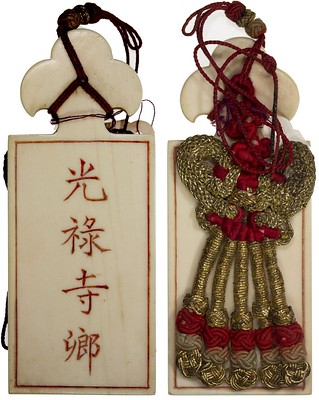
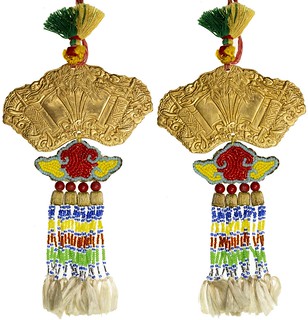
Lots 1536 and 1606
LOT 1536. NGUYEN DYNASTY (ANNAM): bone bài badge (35.12g), Sylvester-6/D/1, 37 x 92 x 6mm, quang loc tu khanh (“Secretary of the Court of Imperial Entertainments”, rank of 3a) etched in red, rectangular border on both sides, ornate butterfly-shaped tassel in red & gold, attached with red cord on badge knob, five braids with three knots each, AU. Estimated at $600 – 700.
LOT 1606. VIETNAM (SOUTH): AV kim khánh medal, ND (1957-1963), Sylvester & Foster-43, 75 x 42mm, 73.78g (including tassels), Order of Kim Khánh 2nd Class, made with solid gold, five stalks of bamboo in center, a scholar’s scroll behind stretched across the field, the two ends coiled around an ink brush & a sword, framed by two dragons among clouds, attached at top with pink cord, and at bottom with beautiful coral beads, strung together with gold thread into a kim khánh-shaped pendant and four braids that descend into numerous strings of colorful beads ending in white tassels, in original presentation case with the emblem of the Republic of Vietnam, UNC, RRR. Estimated at $8,000 - 10,000.
The auction can be viewed on the firm’s website www.stevealbum.com.
Questions about the collection can be directed to the firm’s general email or phone line: info@stevealbum.com or +1-707-539-2120
THE BOOK BAZARRE
ARCHIVES INTERNATIONAL AUCTION 64
Here is the announcement for the January 27, 2021 sale by Archives International Auctions. -Editor
HISTORIC REPUBLIC OF HAWAII, 1896 GOVERNMENT BONDS AT AUCTION WITH OVER 1100 ADDITIONAL SCRIPOPHILY, COIN & EPHEMERA LOTS AT ARCHIVES INTERNATIONAL AUCTIONS JANUARY 27, 2021 AUCTION
The auction will be held by Archives International Auctions at their offices in River Edge, N.J.
 The January 27 th , 2021 auction by Archives International Auctions will
consist of 1114 lots offered beginning with 948 lots of U.S. and Worldwide Scripophily followed by 165 lots of Historic Ephemera, Security Printing Ephemera and U.S. and World Coins, Medals and Military Decorations and ending with U.S. and World Checks, Drafts and Exchanges.
The January 27 th , 2021 auction by Archives International Auctions will
consist of 1114 lots offered beginning with 948 lots of U.S. and Worldwide Scripophily followed by 165 lots of Historic Ephemera, Security Printing Ephemera and U.S. and World Coins, Medals and Military Decorations and ending with U.S. and World Checks, Drafts and Exchanges.
“During this difficult time period for our country and the world, we are striving to offer our clients and friends items of historical and collecting interest that have been off the market for decades or are new to the collecting world. We hope this auction will add a small amount of enjoyment to everyone’s lives”, stated Dr. Robert Schwartz, President of Archives International Auctions. “Included in the upcoming auction is a wide variety or rare, interesting and desirable numismatic and historical objects to enhance the collections of every level of collector and dealer”.
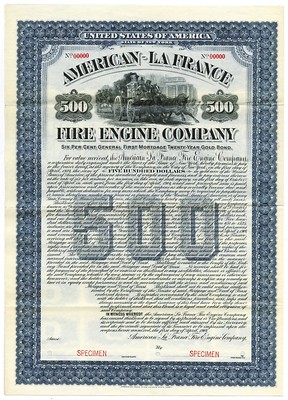
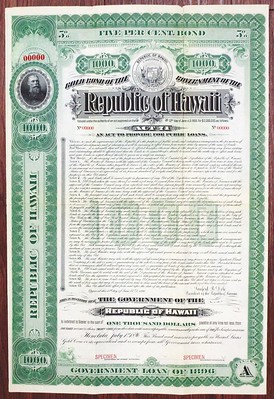
Lots 9 and 281
The auction begins with 948 lots of U.S. and World Scripophily highlighted by 2 extremely rare Republic of Hawaii, Government Loan of 1896, Act. 71, $500 and $1000 Specimen Bond pair including all of the coupons attached from the American Bank Note Company archives. Only 2 or 3 examples are known for these rare bonds which rarely if ever appear at auction.

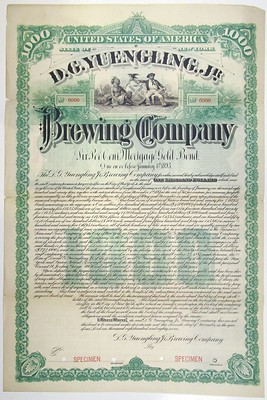
Lots 80 and 93
The auction begins with 50 lots of desirable automobile and aviation stocks and bonds with many rare items seldom offered including a 1904 American-La France Fire Engine Company Specimen bond rarity with an early horse drawn Steam Fire Pumper; and a 1939, Porterfield Aircraft Corporation Issued and Uncancelled stock certificate. Transportation issues were followed by 36 lots of Banking, Finance and Insurance bonds and shares featuring a 1987, Berkshire Hathaway Specimen Registered Bond with the facsimile signature of Warren Buffett as president; an 1815, Bank of Germantown , Pennsylvania stock certificate rarity; and additional bonds and shares from Morgan Stanley, Goldman Sachs IPO Specimen Stock Certificate, Bear Sterns, NYSE Group, The Bank of New York, The Federal Reserve Bank of Boston and many other desirable certificate. Brewery certificates are highlighted by an extremely rare D.G. Yuengling, Jr. Brewing Company 1887 Specimen bond from the oldest operating brewery in the U.S. Internet, computer and technology bonds and shares are highlighted by a 1988 Specimen Apple Computer stock certificate ; a 1996, possible IPO Amazon.com Specimen Stock certificate as well as examples from Yahoo, Wired (magazine) and Network Solutions specimens. Entertainment related certificates include examples from PIXAR with Steve Jobs facsimile signature; a 1973 HBO (Home Box Office) specimen; a 2004, Dream Works Animation specimen stock certificate; Warner Brothers and many other desirable entertainment related bonds and shares.
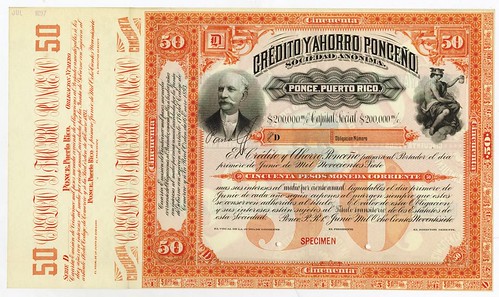
Lot 338: 1897 Credito y Ahorro Ponceno 50 Pesos Specimen Bond
The World Scripophily section includes 203 lots highlighted by 2 lots of the Republic of Hawaii, Government Loan of 1896, Specimen Bond rarities; 23 lots of Chinese Issued and Specimen bonds and shares ; a Banco de Colombia, 1924 Specimen Circulating Bond / Banknote with historic Landing of Columbus scene used on U.S. Banknotes and Stamps as well as 16 additional bonds and shares from Colombia; 20 lots of Mexican bonds and shares; 2 historic Puerto Rico, 1897, Credito y Ahorro Ponceno S.A. , 50 and 200 Pesos Specimen Bonds; a Spain, 1825, Real Compania de Guadalajara , Loan of £600,000. 1825, £100 Sterling I/U Bond Signed by Marquis de Croy, merchants (Knight of the Royal Order) bond rarity and dozens of additional and desirable world bonds and shares.
Other auction highlights include an 1870, United States Freehold Land and Emigration Co. 1870 Bond signed by General Ambrose Burnside as trustee and a 1982, New York, Intrepid Museum Foundation Specimen Bond with a vignette of the Intrepid Aircraft Carrier. Mining, Navigation and Oil & Gas bonds and shares feature 84 lots with many highlights including and 1871, Florida, Southern Inland Navigation & Improvement Co. , Issued and Uncancelled Bond rarity; an 1838, Cairo City and Canal Co. I/C $1000 6% Coupon Bond issued when the town of Cairo, Illinois was formed in 1838 as well as dozens of other attractive and rare bonds and shares. An extremely rare Olympic related bond from the 1932 Olympics is represented by a progress bond proof of the State of California under the "California Tenth Olympiad Bond Act of 1927" with the design of an Olympic Sprinter perched over the 5 Olympic rings symbol.
Railroads are highlighted by over 390 lots of rare and desirable issued and specimen bonds and shares. A few of the many highlights include over 40 Georgia or Georgia related railroad bonds and shares, with many rare issues offered for the first time at auction including an 1888, Florida and Georgia, Georgia Southern and Florida Railroad Co. 1888 Specimen Bond Rarity with this being the only example found in the ABN Archives in 2002; 25 different lots of Kansas railroad bonds and shares with many rare examples offered and featuring an 1880, Atchison, Topeka and Santa Fe Railroad Company $5000 Proof Bond that is an unlisted design in the Cox Railroad Manual by Terry Cox; Ohio is represented by 68 railroad bonds and shares with many issued examples from an old Ohio collection put together in the 1960’s to 1980’s with many rarities offered including an 1865, Marietta and Cincinnati Rail Road Company Stock Certificate found in Issued and Uncancelled condition but unlisted in this format as well as hundreds of desirable railroad bonds and shares rarely seen at auction. Scripophily ends with 75 lots of State and City bonds; Sugar and Tobacco Companies as well as Turnpikes and Utilities.
 Session #2 includes 165 lots of U.S. & World Ephemera, Security Printing Ephemera and Coins, Medals and Military decorations and awards. Highlights from Historic Ephemera section include an English, 1757 Insurance Policy signed by, and issued to Sir Roger Mostyn, 3rd Baronet (ca. 1713 – 16 September 1757) who was an officer of the Royal Navy who saw service during the War of the Austrian Succession and the Seven Years' War; A war of 1812 letter regarding payment for a soldier ; A lot of over 70 pieces of New York Shipping and Canal related documents and receipts and numerous other interesting and historic lots. Security Printing Ephemera includes 47 lots of U.S. and World items including a 1904, ABN Purchase of Franklin Lee BNC, Contract & Documents Group ; High grade American Bank Note Company advertising note selection; A wide variety of proof vignettes used on U.S. Obsolete Banknotes ; an amazing Draper, Underwood, Bald & Spencer , ND, ca.1820's Proof Advertising Sample Sheet and numerous production proof and specimen items from security printers.
Session #2 includes 165 lots of U.S. & World Ephemera, Security Printing Ephemera and Coins, Medals and Military decorations and awards. Highlights from Historic Ephemera section include an English, 1757 Insurance Policy signed by, and issued to Sir Roger Mostyn, 3rd Baronet (ca. 1713 – 16 September 1757) who was an officer of the Royal Navy who saw service during the War of the Austrian Succession and the Seven Years' War; A war of 1812 letter regarding payment for a soldier ; A lot of over 70 pieces of New York Shipping and Canal related documents and receipts and numerous other interesting and historic lots. Security Printing Ephemera includes 47 lots of U.S. and World items including a 1904, ABN Purchase of Franklin Lee BNC, Contract & Documents Group ; High grade American Bank Note Company advertising note selection; A wide variety of proof vignettes used on U.S. Obsolete Banknotes ; an amazing Draper, Underwood, Bald & Spencer , ND, ca.1820's Proof Advertising Sample Sheet and numerous production proof and specimen items from security printers.
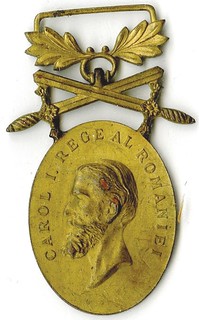 U.S. and World Coins, Medals, Tokens & Military Awards includes over 45 lots in the auction. Highlights include a 1900 to 1980’s Druggist and Pharmacy token collection of over 30 different; an Ontario, Canada, T.H. Robinson - Druggist - Orillia, ca. 1860's One Cent Token Overprinted on a U.S. Large Cent; Spanish American War, World War I and II Service Medals and Awards ; 9 Lots of German States Silver Coins , ca.1900 to 1920’s; 5 Lots of Honduras, 1931 to 1937, 1 Lempira, Silver coins from a new find in Choice XF to uncirculated condition; and Russian, German, French, Eastern European and English Military Service medals and awards. The auction ends with 29 lots of U.S. and World Checks, Drafts and Exchanges.
U.S. and World Coins, Medals, Tokens & Military Awards includes over 45 lots in the auction. Highlights include a 1900 to 1980’s Druggist and Pharmacy token collection of over 30 different; an Ontario, Canada, T.H. Robinson - Druggist - Orillia, ca. 1860's One Cent Token Overprinted on a U.S. Large Cent; Spanish American War, World War I and II Service Medals and Awards ; 9 Lots of German States Silver Coins , ca.1900 to 1920’s; 5 Lots of Honduras, 1931 to 1937, 1 Lempira, Silver coins from a new find in Choice XF to uncirculated condition; and Russian, German, French, Eastern European and English Military Service medals and awards. The auction ends with 29 lots of U.S. and World Checks, Drafts and Exchanges.
Previews will be limited and by appointment only and we will be observing strict safety precautions including the wearing of masks and observing social distancing to protect our team as well as our guests. We will do our best to accommodate anyone who desires additional information and photographs. For questions, please call 201-944-4800 or email info@archivesinternational.com.
The online catalog for the January 27th auction is on Archives International Auctions’ website and can be viewed via the Archives International live bidding platform. It can also be viewed as a Virtual Catalog or downloadable Sale 64 .pdf on our website. To pre-register for Live Internet Bidding, log on to the Archives International Auctions website, at www.ArchivesInternational.com.
Archives International is now working on their Winter and Spring 2021 auctions and are seeking quality consignments for future auctions or outright purchase including U.S. and worldwide banknotes, coins, stocks, bonds, stamps, postal history, historic ephemera, and autographs. To sell or consign one piece or an entire collection, please call AIA at (201) 944-4800; or e-mail them at info@archivesinternational.com.
You may also write to Archives International Auctions, at 1060 Main Street, River Edge, NJ 07661, U.S.A. To learn more about Archives International Auctions and the auctions planned for January 27th , 2021, log on to www.ArchivesInternational.com.
To read the virtual catalog, see:
https://archivesinternational.auctioneersvault.com/catalog/Archivessale64/
To download Auction 64 as a .pdf, see:
https://archivesinternational.net/AIA64_Catalogr.pdf

DAVID LAWRENCE JANUARY 31, 2021 SUPER SALE
Here's the press release for the upcoming David Lawrence Rare Coins January 31, 2021 sale. -Editor
 David Lawrence Rare Coins (DLRC) is proud to announce the upcoming
Super Sunday Sale, featuring a wide variety of Gold Rarities and more selections from the D.L.
Hansen Collection, the Greatest Collection of U.S. Coins, in our upcoming Sunday Internet
Auction #1154. The selection of gold rarities and pieces de-accessioned from the D.L. Hansen
Collection are available for bidding, with lots closing between 8:00pm EST and 11:00pm EST
on Sunday, January 31 st . Showcasing DLRC’s extend-a-bid feature, every coin will have 3
minutes added to its closing time with each bid placed in the closing 3 minutes, giving you the
live auction experience from the comfort of your own home.
David Lawrence Rare Coins (DLRC) is proud to announce the upcoming
Super Sunday Sale, featuring a wide variety of Gold Rarities and more selections from the D.L.
Hansen Collection, the Greatest Collection of U.S. Coins, in our upcoming Sunday Internet
Auction #1154. The selection of gold rarities and pieces de-accessioned from the D.L. Hansen
Collection are available for bidding, with lots closing between 8:00pm EST and 11:00pm EST
on Sunday, January 31 st . Showcasing DLRC’s extend-a-bid feature, every coin will have 3
minutes added to its closing time with each bid placed in the closing 3 minutes, giving you the
live auction experience from the comfort of your own home.


1797 Large Eagle $10
The wide selection of gold rarities features over $1 million in high-end gold rarities that have been held in reserve for this auction event. Including several coins that are fresh from the grading services and new to the market, the highlights in this portion of the sale include the following pieces:
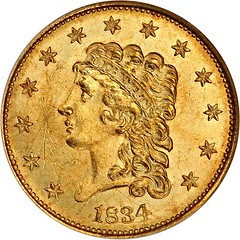

1834 Classic Head $2 1/2
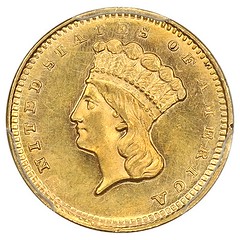
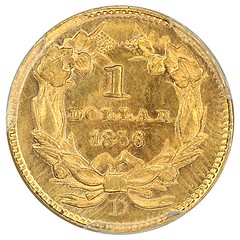
1856-D Gold Dollar
|
|
|
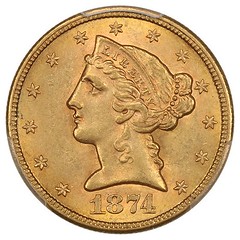

1874-CC Half Eagle
The remainder of the sale features coins that have recently been de-accessioned from the D.L. Hansen Collection. In the latest iteration of sales from DLRC, these pieces were once part of the primary collection of Mr. Hansen, and the opportunity to own a piece of the Greatest Collection of U.S. Coins directly from the owner is a privilege that only DLRC is able to provide. These offerings are one of a kind and span several different series and interests, enabling collectors of all types, values, and levels to own a part of this historic feat.
Please be sure to check out these and other highlights in DLRC’s Super Sunday Internet Auction, ending Sunday, January 31, 2021 beginning at 8:00 PM EST. For more information regarding the auction event or to place a bid, call 800-776-0560 or email at coins@davidlawrence.com.
To view the DLRC website, see:
https://www.davidlawrence.com/
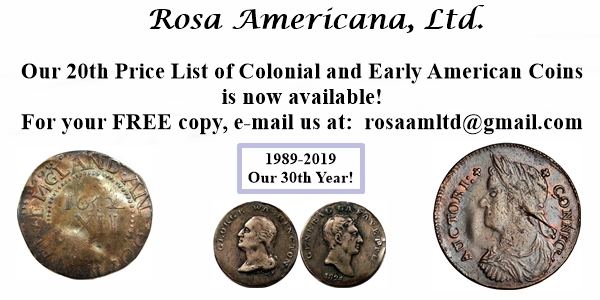
DNW SALE INCLUDES NEWMAN IRISH HALFPENNY
This press release from Dix Noonan Webb in London discusses their upcoming February 2021 sale and features a rare Irish Pattern Halfpenny from the Eric P. Newman collection. -Editor

An extremely rare Irish Proof or Pattern Halfpenny that was bought for the equivalent of $2 many years ago will be offered in a live/online auction of Coins and Historical Medals on Tuesday February 2, 2021 by International coins, medals, banknotes and jewellery specialists Dix Noonan Webb via their website www.dnw.co.uk.
From the collection of the late Eric Newman – an important numatist from the USA - the extremely fine copper coin dates from 1774 and portrays George III with long hair, with a harp on the reverse. It is estimated at £2,400-3,000.
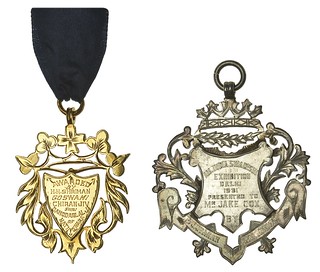 The sale will also include the second and final part of Indian Historical Medals formed by Californian collector Michael Shaw. Comprising 42 lots, the subject matter relates to exhibitions; colleges; individuals through to visits to India by the Prince of Wales in 1875, 1889 and 1921 and the Government of India Cattle Show. Interesting examples include an ornate gold shield, engraved Awarded by H.H. Shriman Goswami Chiranjiv Shri Damodarlalji of Nathdwara and an ornate silver shield dating from 1931 from All India Swadeshi Exhibition, Delhi, engraved Presented to Mr Jake Cox by P. Jawaharlal Nehru. These carry a combined estimate of £300-400.
The sale will also include the second and final part of Indian Historical Medals formed by Californian collector Michael Shaw. Comprising 42 lots, the subject matter relates to exhibitions; colleges; individuals through to visits to India by the Prince of Wales in 1875, 1889 and 1921 and the Government of India Cattle Show. Interesting examples include an ornate gold shield, engraved Awarded by H.H. Shriman Goswami Chiranjiv Shri Damodarlalji of Nathdwara and an ornate silver shield dating from 1931 from All India Swadeshi Exhibition, Delhi, engraved Presented to Mr Jake Cox by P. Jawaharlal Nehru. These carry a combined estimate of £300-400.
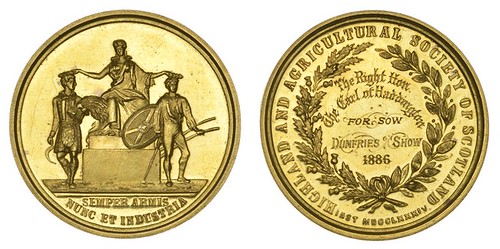
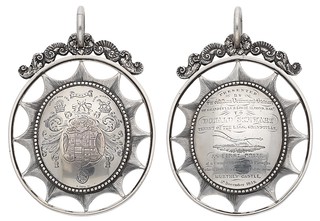 Also of note is a small collection of Agricultural Medals. Many of the medals are Scottish, but not all are. Notable pieces include an extremely fine gold award medal for the Highland and Agricultural Society of Scotland, engraved The Right Hon. the Earl of Haddington, for Sow, Dumfries Show, which is estimated at £650-750, while an elaborate oval silver engraved award medal engraved Presented by Sir William Drummond Stewart of Grandtully and Logiealmond, Bart. to Donald Stewart, Tenant of the Lagg, Grandtully, as First Prize at a Competition of 93 Ploughs which took place at his Estate near Murthly Castle, 5th December 1838 is expected to fetch £300-400.
Also of note is a small collection of Agricultural Medals. Many of the medals are Scottish, but not all are. Notable pieces include an extremely fine gold award medal for the Highland and Agricultural Society of Scotland, engraved The Right Hon. the Earl of Haddington, for Sow, Dumfries Show, which is estimated at £650-750, while an elaborate oval silver engraved award medal engraved Presented by Sir William Drummond Stewart of Grandtully and Logiealmond, Bart. to Donald Stewart, Tenant of the Lagg, Grandtully, as First Prize at a Competition of 93 Ploughs which took place at his Estate near Murthly Castle, 5th December 1838 is expected to fetch £300-400.
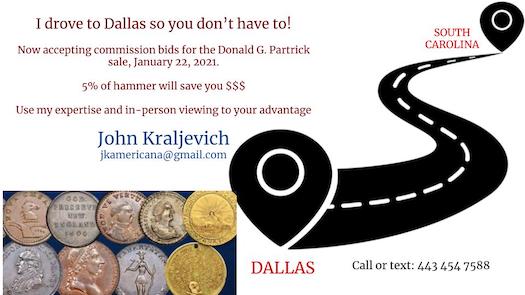
ROBINSON ANCIENT COIN SALE 115 ANNOUNCED
Here's the press release for Frank Robinson's upcoming February sale. -Editor
FRANK ROBINSON ANCIENT COIN AUCTION: MORE SELECTIONS FROM HIS PERSONAL COLLECTION.
Dealer Frank S. Robinson will conduct his 115th mail and internet auction of Ancient and Early Coins with a closing date of February 23. The sale will include 425 lots, with low minimum bids, and bids to be reduced as competition permits. Robinson notes that reductions have averaged 15-20% in his recent sales. There is no buyer fee.
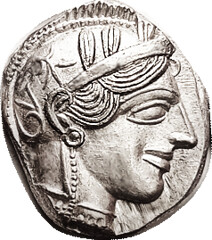
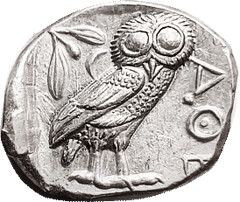
Lot 9
Part of this sale will continue selections from Robinson’s personal collection of Greek and Roman coins. Calling himself a “condition snob,” he had always resolved to keep for himself “only really good stuff.” But after nearly half a century, accumulating thousands of coins, it came time to “decimate” the collection. In Roman times that meant executing every tenth man. Robinson says he similarly picked out about one coin in ten — forcing himself to make choices. Many, he notes are rare and unusual.
This sale will also include offerings from Robinson’s personal collection of early Spanish and early English coins.
The auction further includes Byzantine and other early coinages, group lots, literature, and a section of items offered at fixed prices.
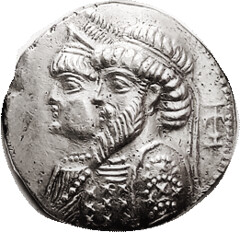
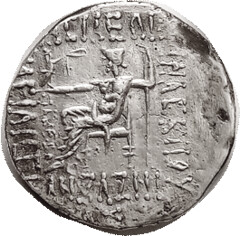
Lot 28
Robinson holds about three auctions annually, and tries to offer a broad range of material for advanced collectors as well as bargain hunters. Catalogs are free; contact Robinson at Box 8600A, Albany, NY 12208; phone/fax 518-482-2639; e-mail frank@fsrcoin.com. The full catalog is at his website, www.fsrcoin.com.

MEDIEVAL AND ROMAN COIN HOARD FOUND IN HUNGARY
A hoard of mostly silver Roman and medieval coins has been unearthed in Hungary. -Editor
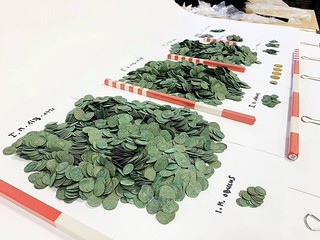 Archaeologists conducting a rescue excavation in the village and commune of Újlengyel, in the Pest County of Central Hungary have unearthed over 7,000 medieval and Roman coins.
Archaeologists conducting a rescue excavation in the village and commune of Újlengyel, in the Pest County of Central Hungary have unearthed over 7,000 medieval and Roman coins.
The excavations were conducted by the Ferenczy Múzeumi Centrum, in collaboration with volunteers from a community archaeology group near the location of a previous hoard, consisting of 150 coins that was discovered in 2019.
Archaeologists opened up a 1×1 metre trench based on a survey by metal detectorists, where they discovered a vessel that had been struck by a plough, dispersing the coins along the plough line. The latest hoard discovery consists of nearly 7,000 silver coins, and 4 gold coins.
The earliest coin is dated from AD 161–169 and depicts the Roman Emperor Lucius Aurelius Verus of the Nerva-Antonine dynasty.
Also identified are several denarii of Aquileia, coins depicting Matthias Corvinus (King of Hungary and Croatia from 1458 to 1490), Vladislaus II (King of Hungary and Croatia from 1490 to 1516), Louis II (King of Hungary, Croatia and Bohemia from 1516 to 1526), and a rare Vatican denarius which was issued by Pope Pius II sometime between 1458 and 1464.
Archaeologists suggest that the hoard was hidden in response to the advancing armies of the Ottoman Empire, after the defeat of the Kingdom of Hungary and its allies, led by Louis II at the Battle of Mohács in 1526 by Suleiman the Magnificent.
Found via The Explorator newsletter. To subscribe to Explorator, send a blank email message to: explorator+subscribe@groups.io. -Editor
To read the complete article, see:
Archaeologists Discover Medieval Treasure Hoard in Central Hungary
(https://www.heritagedaily.com/2021/01/archaeologists-discover-medieval-treasure-hoard-in-central-hungary/136764)
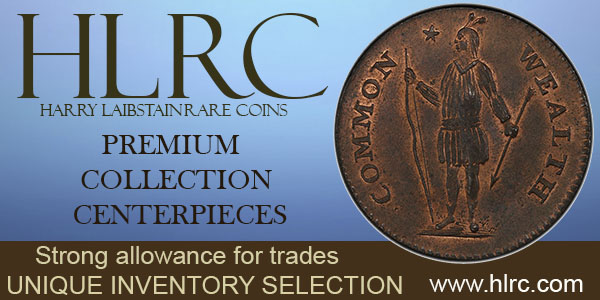
MEDIEVAL JAPANESE COIN HOARD FOUND
Georges Depeyrot forwarded a story in French about the discovery in Japan of a huge hoard of medieval coins. Thanks - great photo! Here's a Google-translated version of the text. -Editor

In Japan, north of Tokyo, in Saitama Prefecture, an ancient ship containing thousands of medieval pieces has been discovered and it is the country's greatest archaeological treasure. The loot, made up of tens of thousands of pieces, was found in a ceramic jar which should date from around the 15th century. The exact number of coins is still uncertain, the exact quantity should be between 100,000 and 260,000, between the Japanese, Chinese coins and those from other neighboring countries.
The jar probably produced in the city of Tokoname, a city famous for its ceramics in Haichi Prefecture, measures 66 cm wide and 74 cm high. It was found two meters underground and on its lid was a wooden tablet less than a millimeter thick, with some inscriptions.
The characters shown "nihyaku rokuju" mean 260 kan, this is probably the number of coins inside. But why was such a treasure buried? Located two meters underground, the treasure was buried to protect the riches of the samurai, which was very common in those troubled times. The 15th century was a very delicate time for Japan, devastated by civil war and under a sort of dictatorial regime exercised not by the emperor but by the shoguns. Violence in the streets was very high, and battles between the feudal lords, the Daimyo, to combat the authority of the shoguns, were the order of the day.
To read the complete article, see:
Découverte au Japon d'une immense jarre contenant 200 000 pièces de monnaie appartenant aux samouraïs.
(https://www.curioctopus.fr/read/18114/decouverte-au-japon-d-une-immense-jarre-contenant-200-000-pieces-de-monnaie-appartenant-aux-samourais)

THE TEMPLETON REID MINT
This article from the Foundation for Economic Education discusses the Templeton Reid Mint. I located the mentioned historical marker in The Historical Marker Database and added an image. -Editor
My primary reason for writing this article is to share with readers a small but fascinating bit of monetary history. It is a story commemorated by a historical marker in Gainesville, Georgia that reads as follows:
1830-1831
Two hundred yards west, on the north side of Washington St., is the site of the first private mint in the United States to manufacture gold coins in dollar values. During the Georgia gold rush, trade suffered due to a shortage of sound money. There were few coins in circulation and most business was by barter.
Templeton Reid (ca. 1787-1851), Milledgeville silversmith and expert machinist, saw an answer to the problem. He decided to buy raw gold, refine it, and stamp coins of proven value, acceptable in any transaction. In 1830 he came to Gainesville, Georgia and opened an assay office. With machines and dies of his design and make he began to strike coins of $2.50, $5.00, and $10.00 denominations. Although questioned by many, this was legal under the U.S. Constitution. The business was not profitable and closed in 1831. The Reid gold coins minted in Gainesville are extremely rare and are eagerly sought by collectors.
 There’s a lot more to the story than you can fit on a sign, and it speaks favorably about markets, entrepreneurship, and competitive choices in money.
There’s a lot more to the story than you can fit on a sign, and it speaks favorably about markets, entrepreneurship, and competitive choices in money.
The 1829 gold rush in the north Georgia mountains was the biggest in America before the fabled discovery of the yellow metal in California 20 years later. At the time, though the official policy of the US government was bimetallism (both gold and silver coin in circulation), the practical effect of Washington’s price-fixing was to put the country on a de facto silver standard. Gold was obviously in demand, but the government minted very little. The Southern Gold Society states, “Some estimates indicate that there was less than one federally minted coin per person in the United States.”
So, as the sign says, Templeton Reid was the first to fill the void by opening his own mint. Where there’s a demand, some enterprising man or woman will rush to provide a supply if given the freedom to do so. In The Georgia Gold Rush: Twenty-Niners, Cherokees and Gold Fever, author David Williams says, “This was exactly what the miners needed—a place to exchange their gold for coin at a not too distant location.”
Previously, miners had to take their gold to the government’s mint in Philadelphia. Not until 1835 did the Congress see the value of opening mints in the gold regions of North Carolina (in Charlotte) and Georgia (in Dahlonega).
Now what about the Reid mint’s short life? The sign says it opened in 1830 and closed in 1831. There’s a story and a lesson to that as well.
Templeton Reid had good intentions but lacked the sophistication to get the proper fineness of gold into each coin he minted. What he stamped as a $10 gold piece, for instance, turned out to be fractionally less pure gold than the coin’s denomination indicated—as the dollar was then defined and as gold was then worth in the marketplace. You might assume Reid was dishonest, but the consensus of historians seems to be that it was imprecision, not fraud, that caused the problem. Williams writes,
As it turned out, Reid’s coins were indeed worth less than face value. It seems Reid failed to take into account the impurities such as silver and tin alloyed with gold in its natural state. An 1835 article in The American Journal of Science and Arts reported than an analysis of a Reid ten-dollar gold piece revealed a purity of 95.579 percent, the remainder being silver. But Reid had assumed the purity of raw gold to be at least 99 percent and stamped his coins accordingly. Though apparently Reid was, in the words of one writer, “more ignorant than greedy,” it was a mistake that proved fatal to his business.
To read the complete article, see:
A Georgia Gold Rush Story: The Rise and Fall of America's First Private Gold-Coin Mint
(https://fee.org/articles/a-georgia-gold-rush-story-the-rise-and-fall-of-americas-first-private-gold-coin-mint/)
For more information, see:
First Private Mint Templeton Reid Mint
1830-1831
(https://www.hmdb.org/m.asp?m=14882)

THE MEXICAN COIN MADE AT THE NEW ORLEANS MINT
Jay Turner published an interesting article on the PCGS blog about the Mexican coin made at the New Orleans Mint. There are two varieties - see the complete article online for more. -Editor

The New Orleans Mint was one of the first three original branch mints established by the United States Mint in 1838. Throughout its history of making coins, much of the bullion used for coinage production came from foreign coin deposits – often in the form of Mexican coinage. Yet, while the New Orleans Mint’s sole task during most of its years of operation was to produce United States coinage, there was one exception: the Mexico 1907 20 Centavos coin.
The first priority of the United States Mint was to produce circulation coinage for domestic commerce, but the U.S. government began accepting contracts in the 1800s to produce coins for other nations. These contracts were often quite lucrative, with various foreign and private mints seeking out this work. While the United States Mint went on to produce more than 1,000 different coins for over 40 countries, only one such coin was produced at the New Orleans Mint.
The contract to produce Mexican coinage began at the United States Mint in 1906 with the production of 1906-dated silver 50 Centavos struck in San Francisco and 1906-dated 5 and 10 Pesos gold coins produced at the Philadelphia Mint. In 1907, Mexico continued to have the United States produce its coinage, with the Denver and San Francisco Mints striking a cumulative 14,841,000 50 Centavos coins. The 1907 20 Centavos were assigned to the New Orleans Mint to produce.
The dies were provided by the Mexico City Mint; the coin features the “M” mintmark for “Mexico.” The New Orleans Mint produced a total of 5,434,699 20 Centavos coins for Mexico. Just two years later, in 1909, the New Orleans Mint struck its last coins and closed its doors for coinage production. The Mexico 1907 20 Centavos coins feature two different varieties. On the “7” of the date, one variety features a “Straight 7” and another exhibits a “Curved 7.” The “Curved 7” varieties are those coins struck by the New Orleans Mint, while the “Straight 7” pieces are minted in Mexico with a mintage of 4,000,000. There also exists both varieties on 1907 50 Centavos coins. However, they are not known to be identifiers of which mint produced them.
To read the complete article, see:
The Mexico Coin Made in the New Orleans Mint
(https://www.pcgs.com/news/mexico-coin-made-in-the-new-orleans-mint)

CHINA MINTS SRI LANKA CENTRAL BANK COIN
Kavan Ratnatunga published an article on The Sunday Times of Sri Lanka about a new coin commemorating the country's Central Bank. The coin was minted in China. -Editor


Chinese coins have been found in Yapahuwa and date back to the period when Lanka paid tribute and was visited six times by Admiral Zheng between 1405 and 1433. 600 years later, China has minted coins for the Central Bank (CB) to celebrate its 70th anniversary. A commemorative 20-rupee Aluminium Bronze collector coin was sold to the public on January 1 for Rs.1300.
Made of Aluminium Bronze, unlike the Silver coins minted for the 40th, 50th, and 60th CB anniversaries, the coin is seven lobed sided, and a specified diameter of 28 mm and 2 mm thickness. The weight not specified was measured at 8.7 grams, approximately to the weight and size of the old Rs. 2 coin except for the shape.
The obverse has image of the CB building and the reverse is similar in design to the new 2017 coins
This coin was planned to be issued on August 20, 2020 and was delayed by the COVID-19 pandemic as the shipment of circulation coins had not yet arrived.
An advance limited lot of 3000 Brilliant Uncirculated coins in presentation boxes, with certificates of authenticity, were air-freighted. The first coin was officially presented to President Gotabaya Rajapaksa, by CB Governor Prof. W D Lakshman on December 31, 2020.
To read the complete article, see:
Chinese mint new Rs.20 coin for Central Bank
(http://www.sundaytimes.lk/210110/business-times/chinese-mint-new-rs-20-coin-for-central-bank-427252.html)
To read about the coin on Kavan;s website, see:
2020 - Sri Lanka - 20 Rupees
Central Bank of Sri Lanka
70th Anniversary
(http://coins.lakdiva.org/commemorative/2020_cbsl70_20r.html)
Kavan adds:
 "I did a lecture on Commemorative Coins of Sri Lanka today on Zoom for the Sri Lanka Numismatic Society
and is posted on Youtube."
"I did a lecture on Commemorative Coins of Sri Lanka today on Zoom for the Sri Lanka Numismatic Society
and is posted on Youtube."
To watch the lecture, see:
Lankan Commemorative Coins
(https://www.youtube.com/watch?v=T1SWXg9A5Hc#t=3m36s)

SARAH SOPHIA BANKS AND THE ‘CONTINENTAL DOLLAR’
Catherine Eagleton's 2014 Numismatic Chronicle article Sarah Sophia Banks and the ‘Continental Dollar’ is available on Academia.edu. Here's an excerpt. -Editor
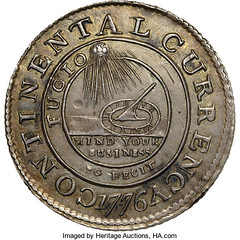 Abstract. Sarah Sophia Banks (1744–1818) was not only an avid coin collector, assembling a numismatic collection of some 9,000 objects, but she also recorded information about where she obtained them, as well as details of their manufacture and uses. This article briefly considers the American coins she collected, now in the British Museum and Royal Mint Museum, which include some of the finest known examples of early US coins. It discusses her as a collector, how her collection was organised, and the information she recorded about one of the most well known of early American coins: the ‘Continental Dollar’ dated 1776. On the basis of information recorded by Sarah Sophia Banks, it is argued that the piece may never have been intended as a coin at all, not struck in America, or even made in 1776. As well as prompting discussion about this important and highly collectible coin, this article therefore underlines the importance of historic collections as sources of information about the objects they contain.
Abstract. Sarah Sophia Banks (1744–1818) was not only an avid coin collector, assembling a numismatic collection of some 9,000 objects, but she also recorded information about where she obtained them, as well as details of their manufacture and uses. This article briefly considers the American coins she collected, now in the British Museum and Royal Mint Museum, which include some of the finest known examples of early US coins. It discusses her as a collector, how her collection was organised, and the information she recorded about one of the most well known of early American coins: the ‘Continental Dollar’ dated 1776. On the basis of information recorded by Sarah Sophia Banks, it is argued that the piece may never have been intended as a coin at all, not struck in America, or even made in 1776. As well as prompting discussion about this important and highly collectible coin, this article therefore underlines the importance of historic collections as sources of information about the objects they contain.
Around 1815, Sarah Sophia compiled a catalogue of her collection in seven volumes, based on an earlier catalogue that had been compiled in or before 1790 with the help of her brother’s librarian, Jonas Dryander. Within these manuscript volumes, the sections are given drawer numbers, referring to the wooden cabinets in which the collection was stored, and these map out the world, with the coins arranged by country, starting with Europe, before moving to Africa, the Middle East, Asia, and finally to the Americas.
The catalogues and provenance lists, and her archive of newspaper cuttings and memoranda, were given to the British Museum along with Sarah Sophia’s numismatic collection after her death in September 1818. The curators selected objects for the British Museum collection, before passing on the remainder, some 2,000 coins, tokens and medals, to the Royal Mint, who had also been given Sarah Sophia’s numismatic library. This huge quantity of material today provides a uniquely rich resource, not just for the study of numismatics at the turn of the eighteenth and nineteenth centuries, but also for understanding more about some of the objects in the collection, thanks to the notes, provenance details, and other information preserved by Sarah Sophia. This short article will look at one particular area of her collection – her American coinage – to show not just what it can tell us about Sarah Sophia and her collection, but also what she can tell us about one of the most well-known of American numismatic rarities, the ‘Continental Dollar’ dated 1776.
Collecting American coins
North America in the early eighteenth century was a turbulent place. The British colonies on the east coast were growing in population and wealth, but coin shortages plagued the thirteen colonies, and official currencies circulated alongside private and token issues. Sarah Sophia Banks had a number of examples of these currencies in her collection, including silver shillings from Massachusetts and Maryland – given to her by George Chalmers, Secretary to the Board of Trade, in 1812 – as well as several examples of the ‘Rosa Americana’ coins, made by the enterprising mineowner, William Wood, in 1722–4. Other examples are the ‘Nova Constellatio’ coins dated 1785 which she described as ‘struck at Greenwich for the American Account’ and various patterns, or trial pieces, of coins featuring a portrait of George Washington, which were prepared by a Birmingham firm hopeful of securing a contract to mint coins for the United States.
To read the complete article, see:
Collecting America: Sarah Sophia Banks and the ‘Continental Dollar’ of 1776
(https://www.academia.edu/16598025/Collecting_America_Sarah
_Sophia_Banks_and_the_Continental_Dollar_of_1776)
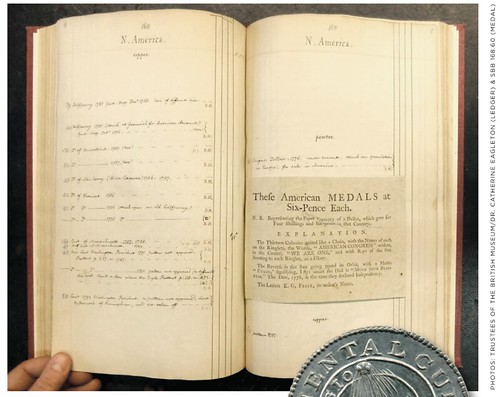
To read earlier E-Sylum article, see:
GOLDSTEIN AND MCCARTHY ON THE CONTINENTAL DOLLAR
(https://www.coinbooks.org/v21/esylum_v21n21a21.html)
NEXT STEPS FOR CONTINENTAL DOLLAR RESEARCH
(https://www.coinbooks.org/v21/esylum_v21n28a19.html)
WHAT'S NEXT FOR THE CONTINENTAL DOLLAR?
(https://www.coinbooks.org/v21/esylum_v21n29a10.html)
FRANKLIN'S 1729 TRACT ON PAPER CURRENCY
This week I came across a 1729 tract by Ben Franklin titled A Modest Enquiry into the Nature and Necessity of a Paper-Currency. Here's an excerpt from a discussion about it from the National Archives; the linked page includes the full text as well. Coincidentally, today is old Ben's birthday, born in Boston in 1706. -Editor
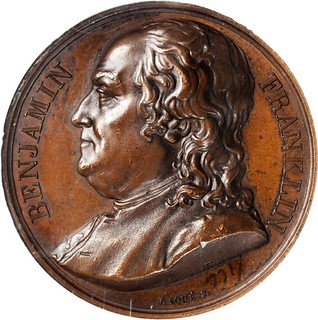 Pennsylvania’s first experience with paper currency came in 1723 with the passage of two acts which provided for issues of bills of credit totaling £45,000. Except for £7,500 allocated to governmental agencies for public expenditure, the new currency was to be loaned to private individuals at 5 per cent interest for specified terms of years on the security of real-estate mortgages. The borrowers were to repay the principal in equal annual installments and the bills of credit received in payment were to be canceled and destroyed. The last of the loans would be repaid and the last bills of credit “sunk” in 1736. But in 1726, when almost £5,000 of the paper money had been retired, complaint about the shrinking currency induced the Assembly to halt the further destruction of the bills and to authorize instead their reissue on new mortgage loans.
Pennsylvania’s first experience with paper currency came in 1723 with the passage of two acts which provided for issues of bills of credit totaling £45,000. Except for £7,500 allocated to governmental agencies for public expenditure, the new currency was to be loaned to private individuals at 5 per cent interest for specified terms of years on the security of real-estate mortgages. The borrowers were to repay the principal in equal annual installments and the bills of credit received in payment were to be canceled and destroyed. The last of the loans would be repaid and the last bills of credit “sunk” in 1736. But in 1726, when almost £5,000 of the paper money had been retired, complaint about the shrinking currency induced the Assembly to halt the further destruction of the bills and to authorize instead their reissue on new mortgage loans.
During the next few years paper currency became a major issue. Many believed the acts of 1723 and 1726 had greatly promoted the prosperity of Pennsylvania; others, including the more conservative inhabitants, the proprietors in England, and officials of the British government, feared inflation and serious depreciation of the paper money such as had already taken place in New England and South Carolina. The Assembly, acting on several petitions, sent to the governor in February 1729 a bill for a large new emission of bills of credit, with a lower interest rate on the mortgage loans and a longer term for retirement than any earlier Pennsylvania act had provided. Governor Patrick Gordon favored paper currency but objected to the terms of the bill. Prolonged discussions followed between governor and Assembly.
While these negotiations were in progress Franklin joined the debate. He and his friends had discussed the matter in the Junto, he wrote many years later in his autobiography, and he was “on the Side of an Addition.” He remembered the stagnant condition of the city when he “first walk’d about the Streets of Philadelphia, eating my Roll,” in 1723 just before the first of the currency acts began to take effect, and by contrast the prosperity that had followed. He attributed the great improvement to the more plentiful supply of a circulating medium. “Our Debates possess’d me so fully of the Subject, that I wrote and printed an anonymous Pamphlet on it, entituled, The Nature and Necessity of a Paper Currency.” This essay was dated April 3, 1729, and was one of the first of the publications issued by the new firm of Franklin and Meredith “at the New Printing-Office near the Market.”
The first part of this paper is a discussion of the importance of an adequate supply of money for the successful conduct of a community’s business. The treatment is general but has particular application to a colonial area such as Pennsylvania. Some of Franklin’s ideas may have been derived from his reading; others doubtless reflected the discussion then going on in the province at large and among his friends in the Junto. The second part of the essay deals with the specific question of how much paper currency might be safe for a community and how it should be secured to avoid the danger of a serious depreciation.
To read the complete article, see:
The Nature and Necessity of a Paper-Currency, 3 April 1729
(https://founders.archives.gov/documents/Franklin/01-01-02-0041)

DEL MONTE BANANA LABEL ERROR NOTE POPULAR
That banana-sticker note is getting a lot of publicity. This CNN article is nicely done and gets into the numismatic details with quotes from NNP's Len Augsburger and Dustin Johnston of Heritage. Here's an excerpt, but be sure to see the complete article online. -Editor
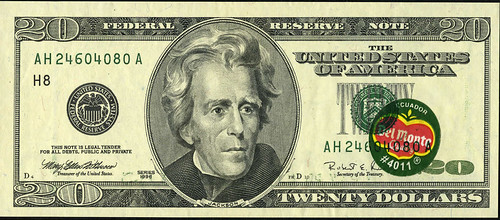
How can a $20 bill be worth over $57,000? Because of a printing mishap.
The "Del Monte note," a rare $20 banknote with a banana sticker on it, is currently for sale through Heritage Auctions, a Dallas-based auction house. Currency collectors are paying close attention and breaking previous bidding records with their offers, according to Heritage Auctions.
"The note has been viewed on our website over 4,300 times," Dustin Johnston told CNN. He's the vice president and managing director of the currency department with Heritage Auctions.
The banknote, from the 1996 series, is unique because of the sticker, which found its way onto it between stages of the printing process, and has part of the Treasury seal and the note's serial number printed over it.
Current bidding for the note is at $57,500, for a total cost of $69,000 after a buyer's premium is applied.
"Most 'obstructed error' notes result from a loose piece of paper, scotch tape, band-aid, or other detritus becoming attached to the currency stock during the printing process and later falling off. Most notes of this class thus exhibit a blank area somewhere on the note," said Leonard Augsburger, the project coordinator of the Newman Numismatic Portal at Washington University in St. Louis.
He said most banknotes featuring obstructions will sell for between $100 to $1000.
"The Del Monte note is more spectacular," Augsburger added.
"This is one of those really incredible errors that is immediately obvious. It's tactile, so if you're pulling [money] out and you're just counting it, you're probably gonna feel just the increased height of the sticker. And then of course the color just jumps out at you," Johnston added.
In 2003, the note sold on eBay for around $10,000. It was sold again in 2006, in an auction by Heritage Auctions, and at that time it went for over $25,000.
Johnston told CNN that the note is so important that, for both auctions, he flew to pick it up in person and bring it back to the auction house.
"By examining the sticker and the overprint, it is clear that the sticker was applied after the front was printed and before the serial number and seal were applied," Augsburger said.
"The placement of the sticker is intriguing -- if it were placed in most areas of the note it would not be possible to prove that it was applied between the second and third stage. This suggests a deliberate placement," he added.
Johnston told CNN the sticker could have been affixed to the note for testing purposes.
"Over the last 20 to 30 years, the Bureau of Engraving and Printing has started using optical recognition to review the notes as they come off the printing press. Previously people did that," Johnston explained.
To read the complete article, see:
Auction bids are topping $57,000 for a rare $20 banknote with Del Monte sticker on it
(https://www.cbs58.com/news/auction-bids-are-topping-57-000-for-a-rare-20-banknote-with-del-monte-sticker-on-it)
To read the earlier E-Sylum articles, see:
DEL MONTE BANANA LABEL ERROR NOTE SELLS FOR $25,300
(https://www.coinbooks.org/esylum_v09n02a05.html)
DEL MONTE BANANA LABEL ERROR NOTE OFFERED
(https://www.coinbooks.org/v23/esylum_v23n49a35.html)
LOOSE CHANGE: JANUARY 17, 2021
Here are some additional items in the media this week that may be of interest. -Editor
Cycles of the US Rare Coin Market
Dave Bowers published a nice article on CoinWeek about the "Cycles of the US Rare Coin Market 1900 to Date." -Editor
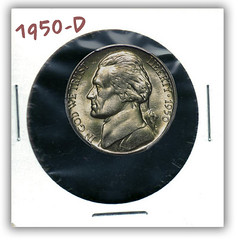 A coin market survey of the early 1900s showed that encased postage stamps and Hard Times tokens were high on the popularity list. At the same time, a Mint State 1893-S Morgan dollar would have attracted very little interest. It seems that fewer than a half dozen numismatists collected Morgan dollars by mintmark varieties, although collecting Philadelphia Mint Proofs was popular. This is certainly strange to contemplate today!
A coin market survey of the early 1900s showed that encased postage stamps and Hard Times tokens were high on the popularity list. At the same time, a Mint State 1893-S Morgan dollar would have attracted very little interest. It seems that fewer than a half dozen numismatists collected Morgan dollars by mintmark varieties, although collecting Philadelphia Mint Proofs was popular. This is certainly strange to contemplate today!
To read the complete article, see:
Q. David Bowers: Cycles of the US Rare Coin Market 1900 to Date
(https://coinweek.com/us-coins/q-david-bowers-cycles-of-the-us-rare-coin-market-1900-to-date/)
Max von Bahrfeldt
Another good CoinWeek piece is Mike Markowitz's article on Max von Bahrfeldt. -Editor
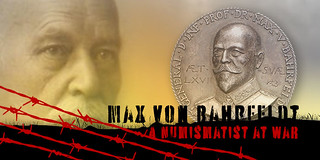 The study of ancient coins is usually regarded as a quiet, scholarly pursuit. But one of the most eminent European classical numismatists of the early 20th century was a German general accused of atrocities in Belgium during the First World War.
The study of ancient coins is usually regarded as a quiet, scholarly pursuit. But one of the most eminent European classical numismatists of the early 20th century was a German general accused of atrocities in Belgium during the First World War.
Born in 1856 to an upper-middle-class family in Willmine, 45 miles (72 km) northeast of Berlin, Max Bahrfeldt entered a Prussian military academy in 1869. In 1871, the 15-year-old cadet purchased his first Roman coin, the beginning of a lifelong devotion to numismatics (Schaefer, 276). Bahrfeldt was commissioned as an infantry lieutenant in 1873, and his first published article appeared the following year. He was promoted to Colonel (Oberst in German) in 1904, Major General in 1908, and Lieutenant General in 1913. German emperor Kaiser Wilhelm II elevated him to the Prussian hereditary nobility, which entitled him to add the honorific “von” to his family name.
To read the complete article, see:
A Numismatist at War: Max von Bahrfeldt
(https://coinweek.com/ancient-coins/a-numismatist-at-war-max-von-bahrfeldt/)
Dad Gives Kid Rare Coin; Kid Swallows It
The Daily Mail Australia has this story of a coin-collecting Dad who gave a coin to his toddler, who promptly ate it. -Editor
 A keen young coin-collector was rushed to hospital after swallowing a rare 1c coin he was given by his own dad.
A keen young coin-collector was rushed to hospital after swallowing a rare 1c coin he was given by his own dad.
An x-ray showed the coin lodged in the left-hand side of the toddler's stomach.
The relieved Sydney father, Scott, posted updates on Facebook in a coin-enthusiast group.
'So the son decided that his mouth was a good spot to stick a 1c coin I had found earlier and given to him to put with his coins.'
Later he posted again saying his boy hadn't suffered any adverse effects and was able to pass the coin within 24 hours.
To read the complete article, see:
Dad who proudly presented his coin-collecting son with a rare 1c piece winds up rushing the boy to hospital after he SWALLOWS it
(https://www.dailymail.co.uk/news/article-9132275/Sydney-dad-gave-coin-collecting-son-rare-1c-piece-rushes-hospital-swallowing-it.html)
The Sum Total of All Human Knowledge
From the "Great Internet Memes" department. Guess my library coulda been a lot smaller... -Editor
